Since I was seven or eight years old, I have been fascinated by all things history. Luckily in my (now almost twenty-four) years of living, I have managed to visit some pretty interesting places and learn lots of local history. Here are some of my adventures I've had along the way.
2007-Visiting Sentimental Journey at the Commemorative Air Force Museum, Mesa, Arizona, United States of America
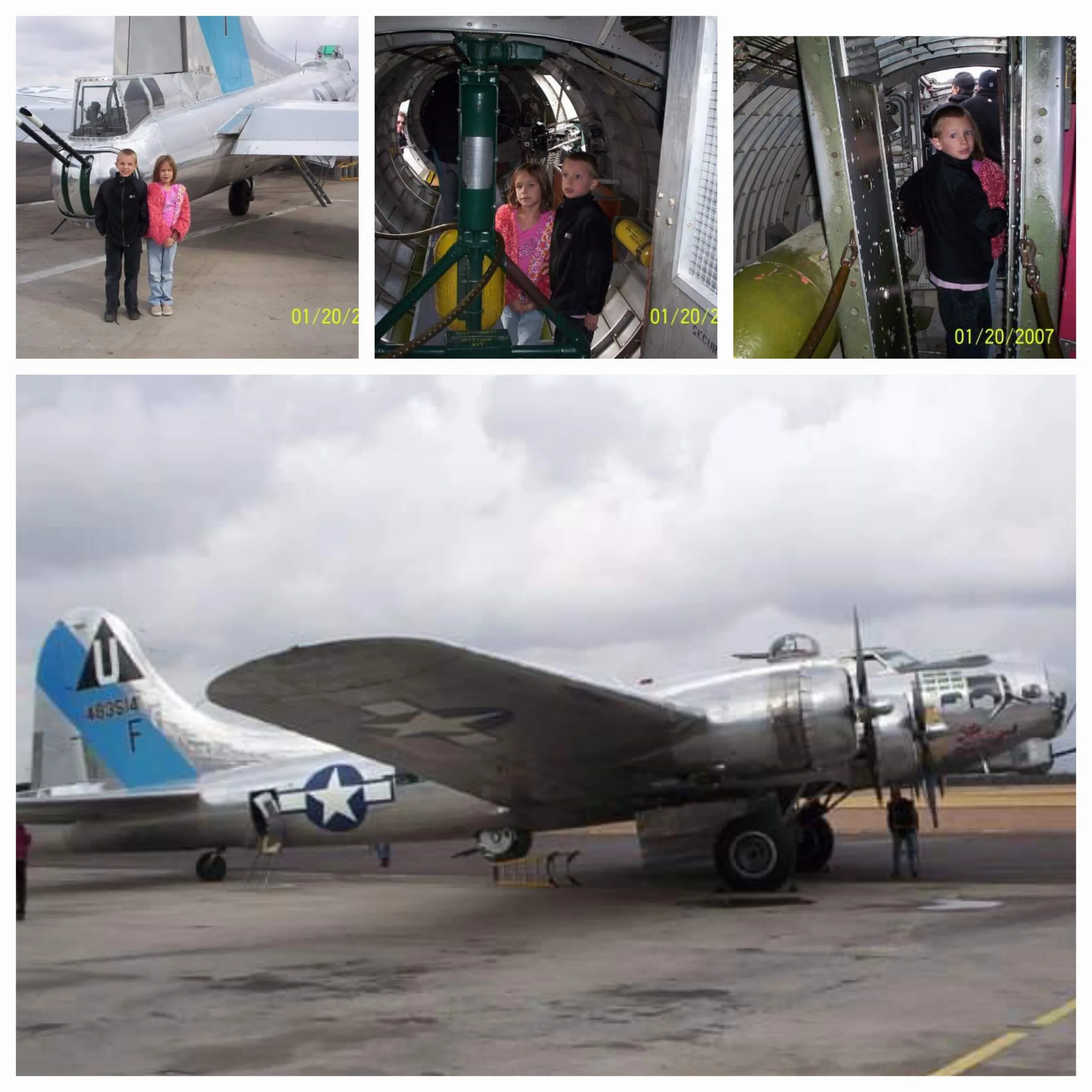
Sentimental Journey is a B17-G Flying Fortress who served the United States military doing active bombing raids during World War II.
According to the Commemorative Air Force Museum's website, (linked here), Sentimental Journey is one of only five B17 bombers still flying today.
Sentimental Journey holds a special place in my family's heart. My maternal grandfather Dale raised my brother, cousins, and I to love and appreciate this particular aircraft from the time we were tiny. These pictures are from just before my seventh birthday, when my brother and I were lucky enough to step inside of the airplane.
Sentimental Journey spends the majority of her time at the Commemorative Air Force Museum, located near Falcon Field airport in my hometown of Mesa, Arizona.
When we were tiny, my grandpa would always take my cousins and I to Falcon Field to watch the planes take off and land. He would always buy us a cup of hot chocolate and some Cheetos from the vending machine. The ladies who worked in the office at the air field always knew us on sight because, while my grandpa intended for us to sit still and watch the planes, in reality us kids were too busy running around and banging ourselves up on the rocks. We frequently used up all of the bandages in the office first aid kit. Falcon Field will always hold memories for my family, and Sentimental Journey was one of the first pieces of history I was given the opportunity to learn about and see and feel with my own eyes and hands.
2011, 2012, and 2021--The Copper Queen Mine Tour, Bisbee, Arizona, United States of America
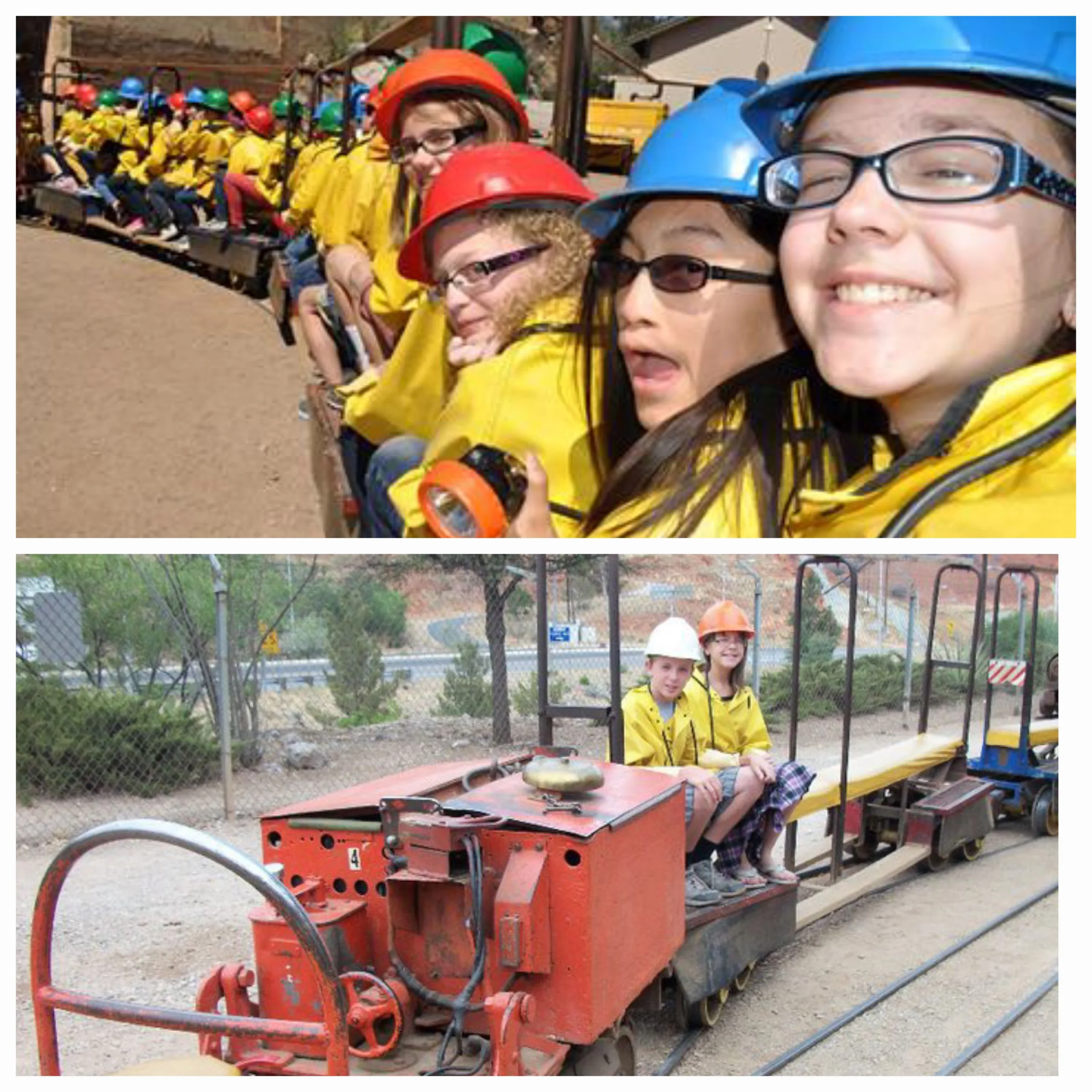
I have had the opportunity to visit the Copper Queen three times in my life, and if you ever visit Bisbee, Arizona I HIGHLY recommend taking the tour yourself (unless you are claustrophobic and hate being underground in which case you won't have nearly as much fun...like my poor friend Sierra on our Seventh Grade History trip which is the top photo in this section).
Copper was mined in Bisbee from the 1880s until 1975. Bisbee was one of the leading exporters of copper for the state of Arizona, to the point that schoolchildren in Arizona are taught about the "Five C's of Arizona" -- Copper, Climate, Citrus, Cattle, and Cotton.
The Queen Mine Tour officially opened in February of 1976, less than a year after the mine had officially closed. The tour has continued ever since, with participants getting to take a ride deep into the mines on the same train that used to carry miners to work and back every day.
To learn more about the Copper Queen, or to schedule a tour yourself, visit their website here.
2012- Pima Air and Space Museum, Tucson, Arizona, United States of America
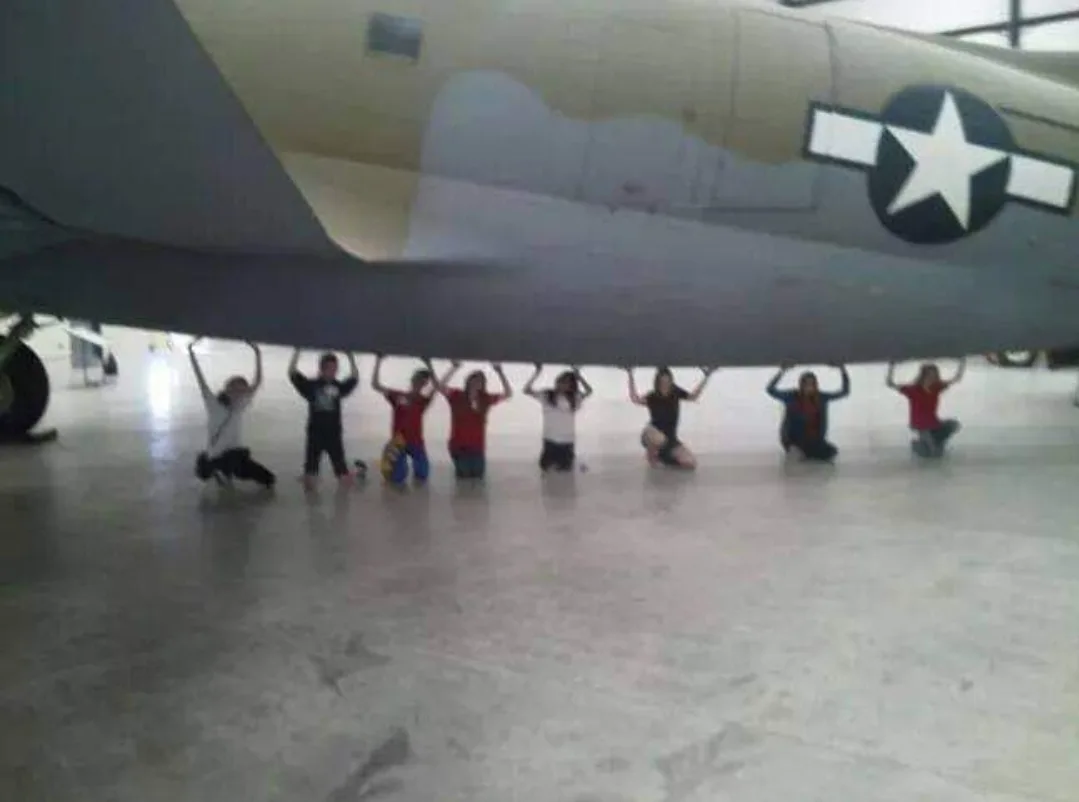
On that same seventh grade history trip I mentioned above, my class also stopped at the Pima Air and Space Museum, in Tucson, Arizona.
The museum's initial idea dates back to 1966, and remains open to this day. Of all the aerospace museums I've visited over the years, the Pima Air and Space Museum is definitely one of, if not the coolest museums I have ever stepped foot in, and if you have not had the chance to visit yourself, I cannot recommend it enough. To learn more about the museum or get tickets, visit the museum's website here.
2015--Alcatraz Island, San Francisco, California, United States of America
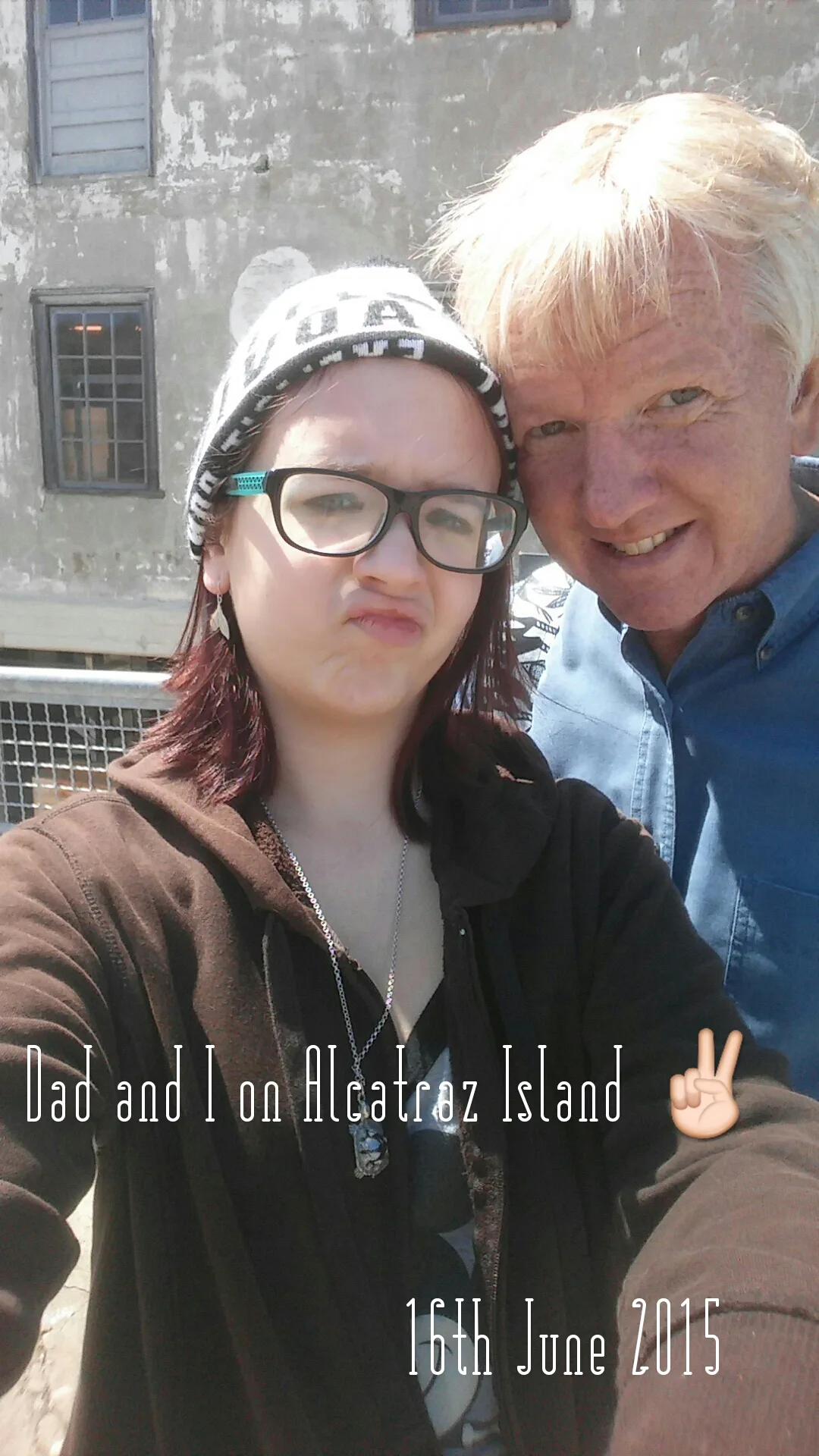
Before I say anything else, first let me apologize for my face in this photo. I was a stupid fifteen year old who thought it was a good look. I know now that it most definitely was NOT a good look for any photograph, especially one with my dad at a historic site.
But I can't change the past and this is the only photo I have remaining so with that said...
Alcatraz Island, also known as "The Rock."
I visited Alcatraz with my parents and brother in June of 2015, which is the warmest month of the year to visit San Francisco. I know this because a few years later, one of my oldest friends competed in a swimming competition from Alcatraz back to San Francisco and every year that competition is held in June because again, its the only month out of the year that the water is warm enough for the swimmers to compete safely. Yikes!
As for Alcatraz itself, for those unaware, the island is best remembered for being a federal prison for many years, but is so much more than that. As described by the National Park Service, Alcatraz has been a "Civil War fortress, military prison, federal prison, bird sanctuary, first lighthouse on the West Coast, and the birthplace of the American Indian Red Power movement."
Alcatraz served as a military installation from 1850 to 1934, a federal prison from 1934 to 1963, and was occupied by several different Native American activist groups in 1964, as well as again from 1969 to 1971. In 1973, Alcatraz Island officially opened as a tourist destination for the general public and is now considered a National Park.
In order to get to Alcatraz, tourists take a ferry ride from San Francisco across the bay to the island. The standout part of the journey for me was the fact that all of the TV screens on the ferry, which displayed safety information for guests once they reached the island, also had interpreters giving those same instructions in American Sign Language. This is much more common now in 2024, but eight years ago in 2015 this was something I hardly ever saw and so it stood out in my memory.
To learn more about Alcatraz and its history, click here.
2015--The Winchester Mystery House, San Jose, California, United States of America
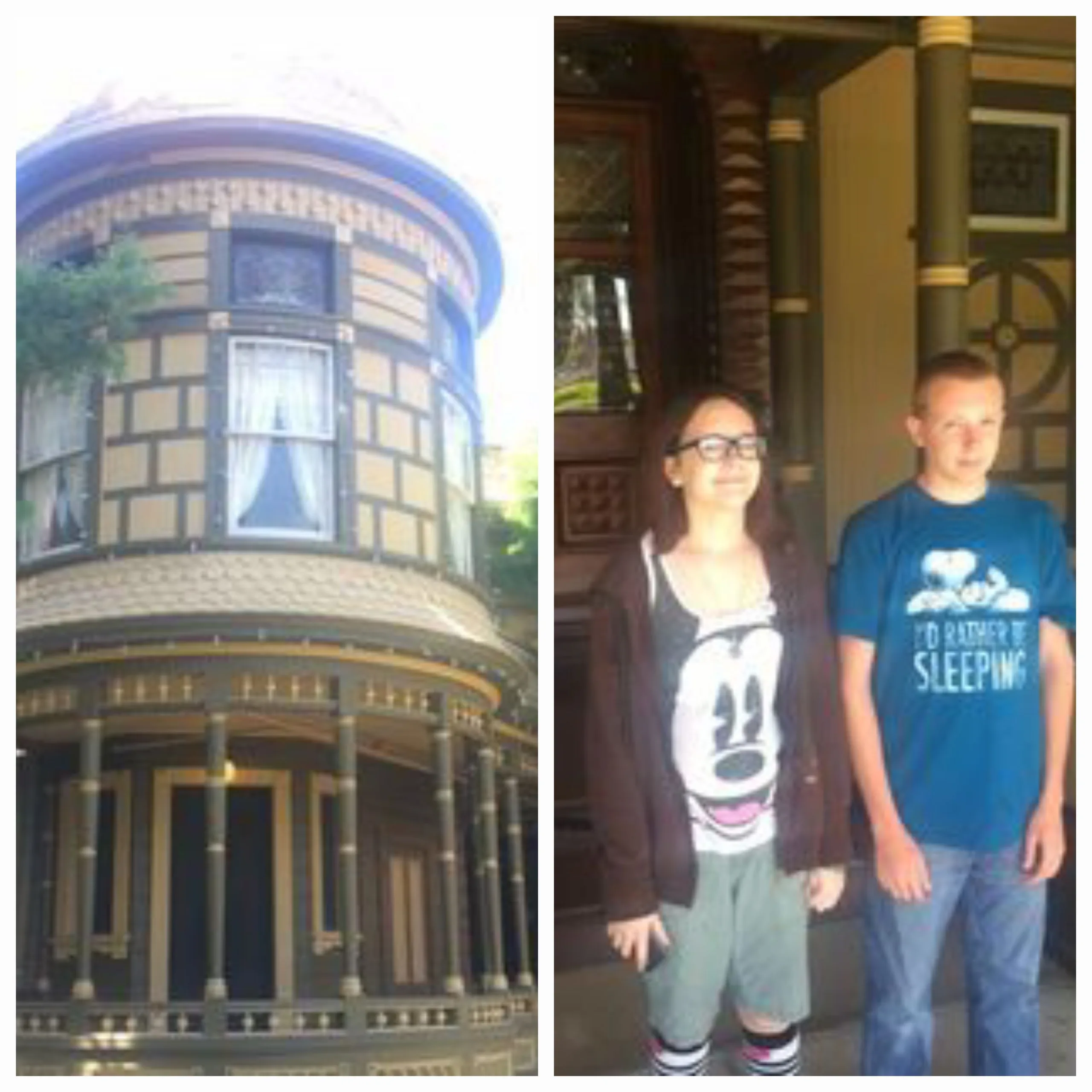
After leaving Alcatraz, and San Francisco, behind, my parents, brother, and I traveled to San Jose, in order to visit the famous Winchester Mystery House.
To learn more about the house and its famous owner, check out my article on Mrs. Winchester herself, here.
Between 1886 and 1922, Sarah Winchester converted an eight bedroom farmhouse into a confusing mansion with the following features (according to the official Winchester House website, which you can access here).
-24,000 square feet
-10,000 windows
-2,000 doors
-160 rooms
-52 skylights
-47 stairways and fireplaces
-17 chimneys
-13 bathrooms
-6 kitchens
-Built at a price tag of the $5 million dollars in 1923 or $71 million today
My family sprang for the fancy tour, so we were allowed to see the inside of the mansion as well as some of the outer buildings. Unfortunately the tour did not allow for guests to take photos inside of the mansion, so enjoy our crusty, low-quality photos of us outside the house instead!
2015--Visiting a Random World War II Tank in Pennsylvania, United States of America
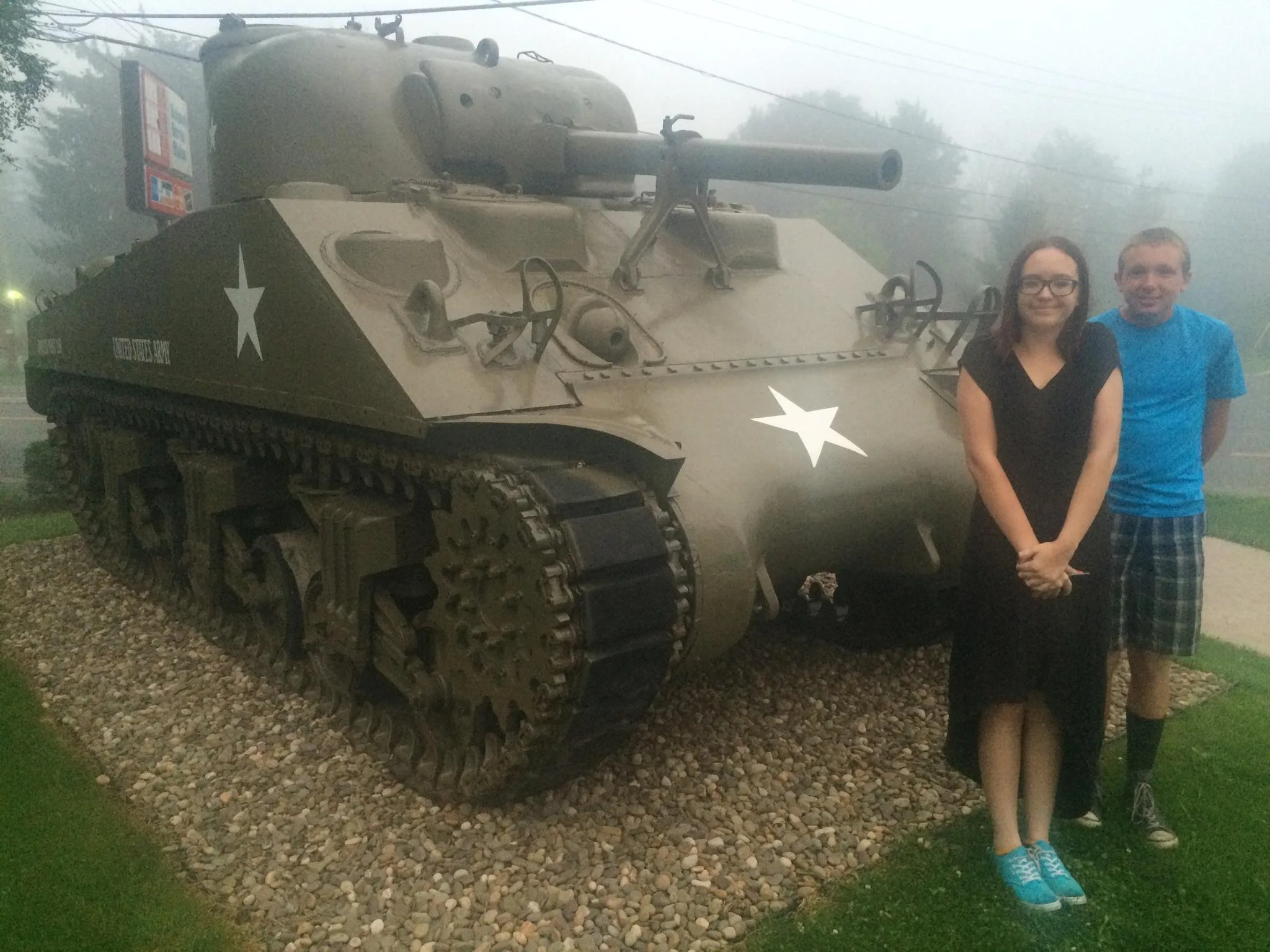
For my brother's eighteenth birthday, our dad took us on a trip back east to visit his family's farm in Pennsylvania. While we were out driving around, we stumbled across an M4 Sherman Tank just parked on the side of the road. I don't know why an actual World War II tank is sitting in Philipsburg, Pennsylvania, but I got a photo of it! So, enjoy!
2015--Gettysburg Battlefield, Gettysburg, Pennsylvania, United States of America
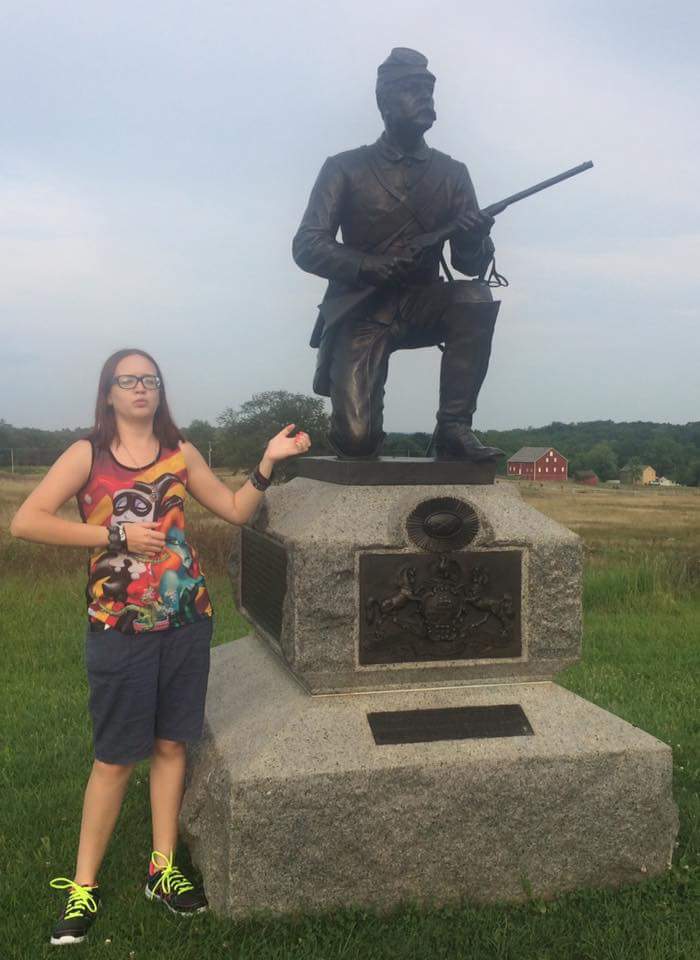
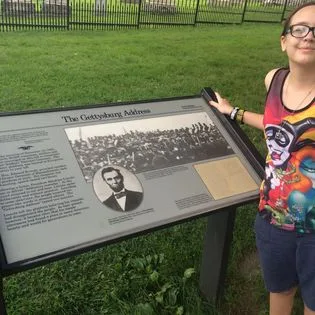
Once again I find myself apologizing for being a goofy fifteen year old. I know now this is not the most appropriate pose for a person to be taking while standing on a literal scarred battlefield, but what can I say I was fifteen and thought it was a good idea.
Anyway! On that same trip for my brother's birthday I mentioned earlier, my dad also took us to Gettysburg, which is both a town people live in and also a National Park, which was really cool to experience firsthand.
For those unaware, Gettysburg was the site of one of the most horrific battles during the War Between the States (and according to the Gettysburg website, linked here, it was actually the largest battle of the entire conflict). The battle occurred over three days in July of 1863, during which time over 51,000 soldiers either died, were wounded, or declared missing--in THREE DAYS.
Immediately after the battle, residents of Gettysburg and preservationists began efforts to ensure Gettysburg would remain as a testament and memorial to those who died. In 1895, the land where the battle had taken place was declared a National Military Park, and in 1933 the area was re-designated to become a part of the National Park Service.
Today, visitors to the park can take a driving tour from their own vehicles, to scout around the area and see just how massive the battle was. There is also a museum and walking areas as well.
2015-Arlington National Cemetery, Arlington, Virginia, United States of America
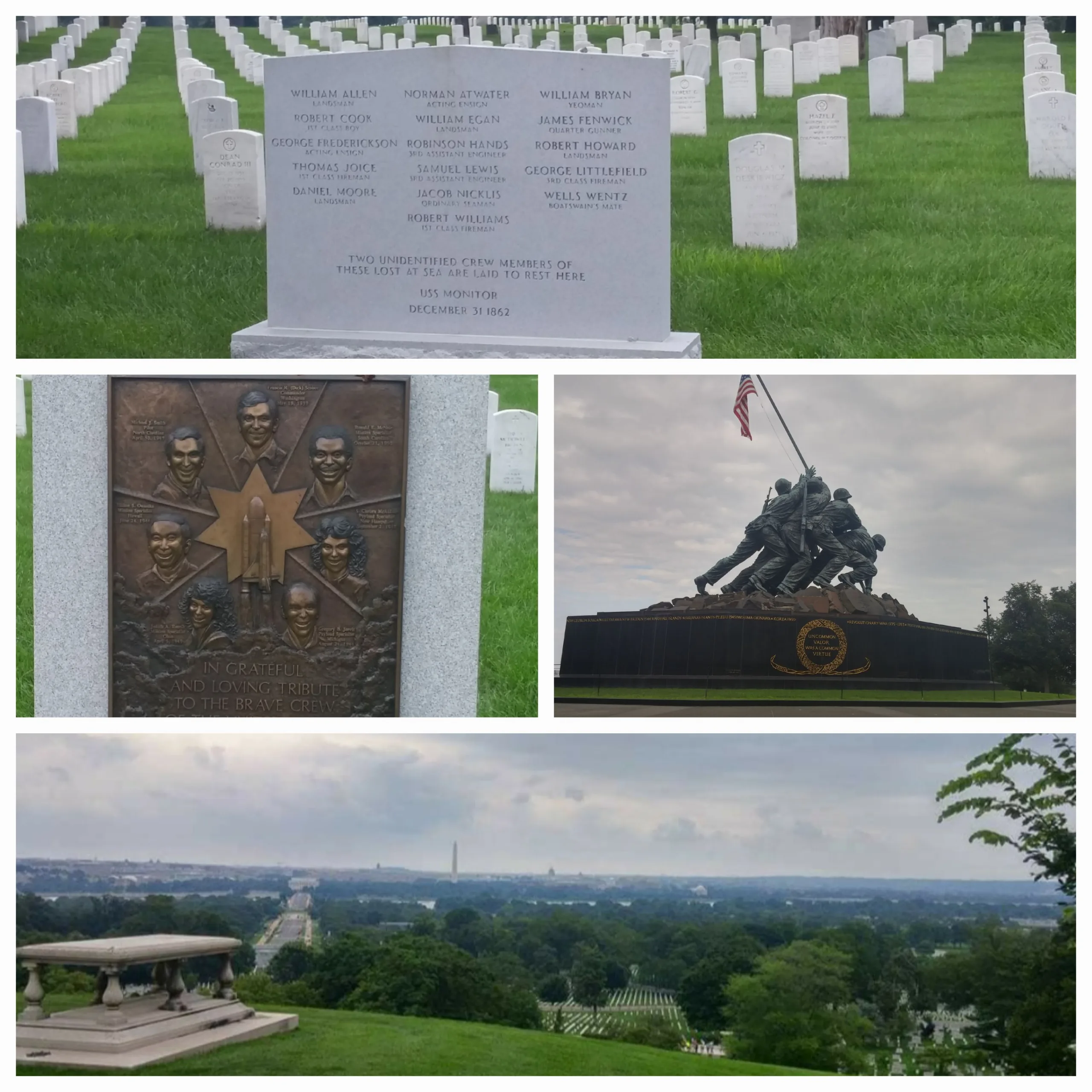
While on that same trip when I was fifteen, we also visited Arlington National Cemetery, the most hallowed burial ground in the United States--but it did not start out that way.
For a more complete history of Arlington, check out my article on its most famous owner, Mary Custis Lee. The short version is this: Mary owned the property and happened to be married to General Robert E Lee, the most famous Confederate General during the War Between the States.
After General Lee went off to fight in the war, his wife and family fled further down into the Confederacy (because Arlington is within sight of Washington DC, which was the capitol of the United States still).
Soon after, it became time for the Custis Lee family to pay their property taxes. Because the United States federal government was upset with General Lee for choosing to fight with the Confederate army, the federal government seized the property after the Lee family failed to pay their taxes.
Soon after seizing the property, the Union army began burying their dead at Arlington. The military did not begin the burials because of Arlington's beautiful and scenic views however. Unfortunately, the burials began to spite the Custis Lee family.
After the conclusion of the war, the Custis Lee family then spent several years fighting with the federal government over the property. Eventually, the federal government purchased the land from the Custis Lee family and continued to bury military veterans there.
As I said, this is an extremely shortened version of events, so please read Mary Custis Lee's biography here on my website or check out the Arlington National Cemetery website here to learn more.
When I visited the cemetery in 2015, I was stunned to not only learn the history behind the property, but also to take in the breathtaking views as well. There are thousands and thousands of graves as far as the eye can see, as well as countless memorials, statues, and other tributes to those who gave their lives for their country. Arlington has graves dating from the Revolutionary War (graves that were re-interred at the cemetery after the creation of the graveyard) all the way to today. According to Arlington's website, they conduct between twenty-seven and thirty funerals every week day and several on Saturdays as well.
If you happen to be in the Washington DC area and have spare time, I highly recommend visiting Arlington National Cemetery to see, honor, and remember.
2015--Washington DC, United States of America
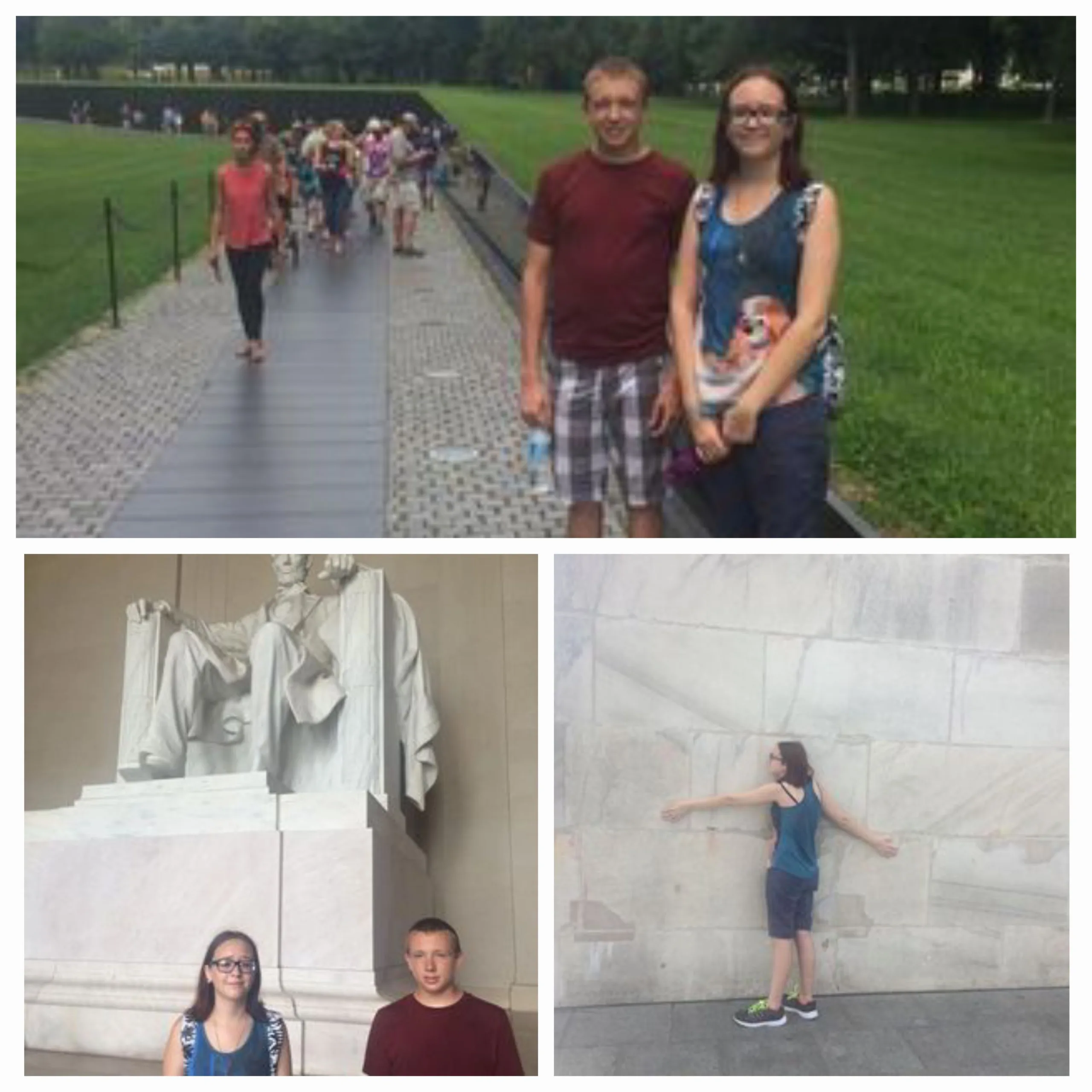
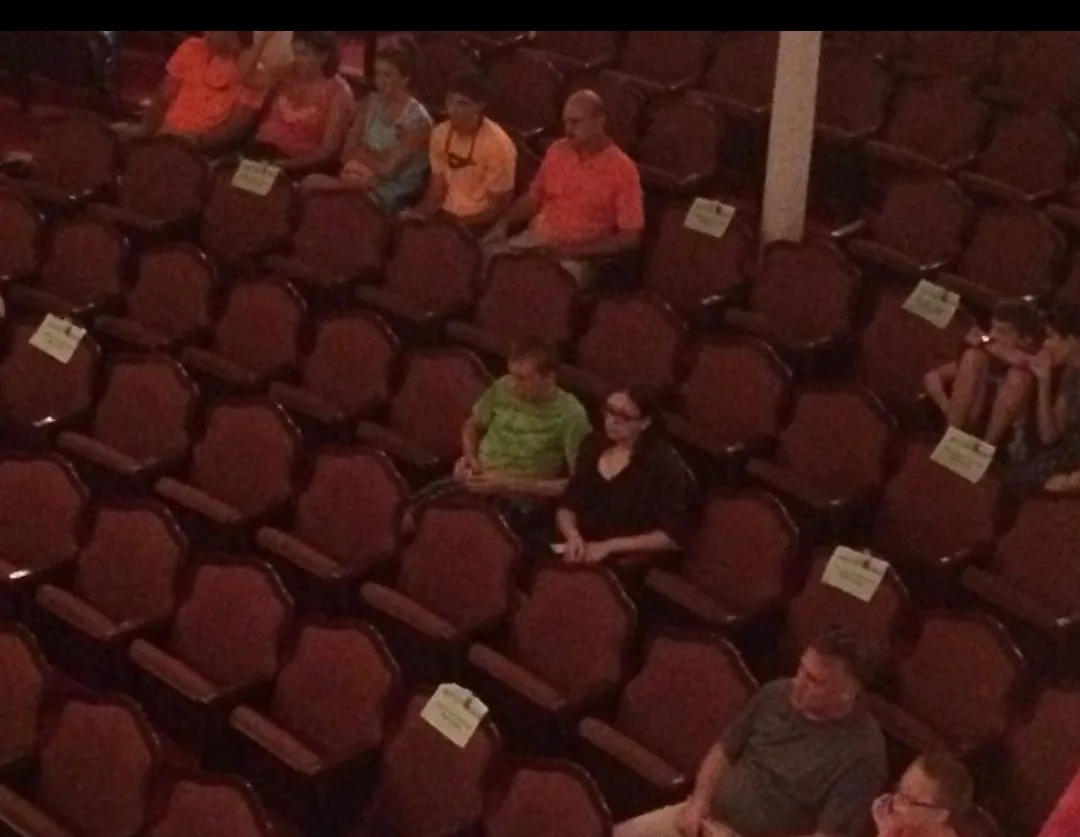
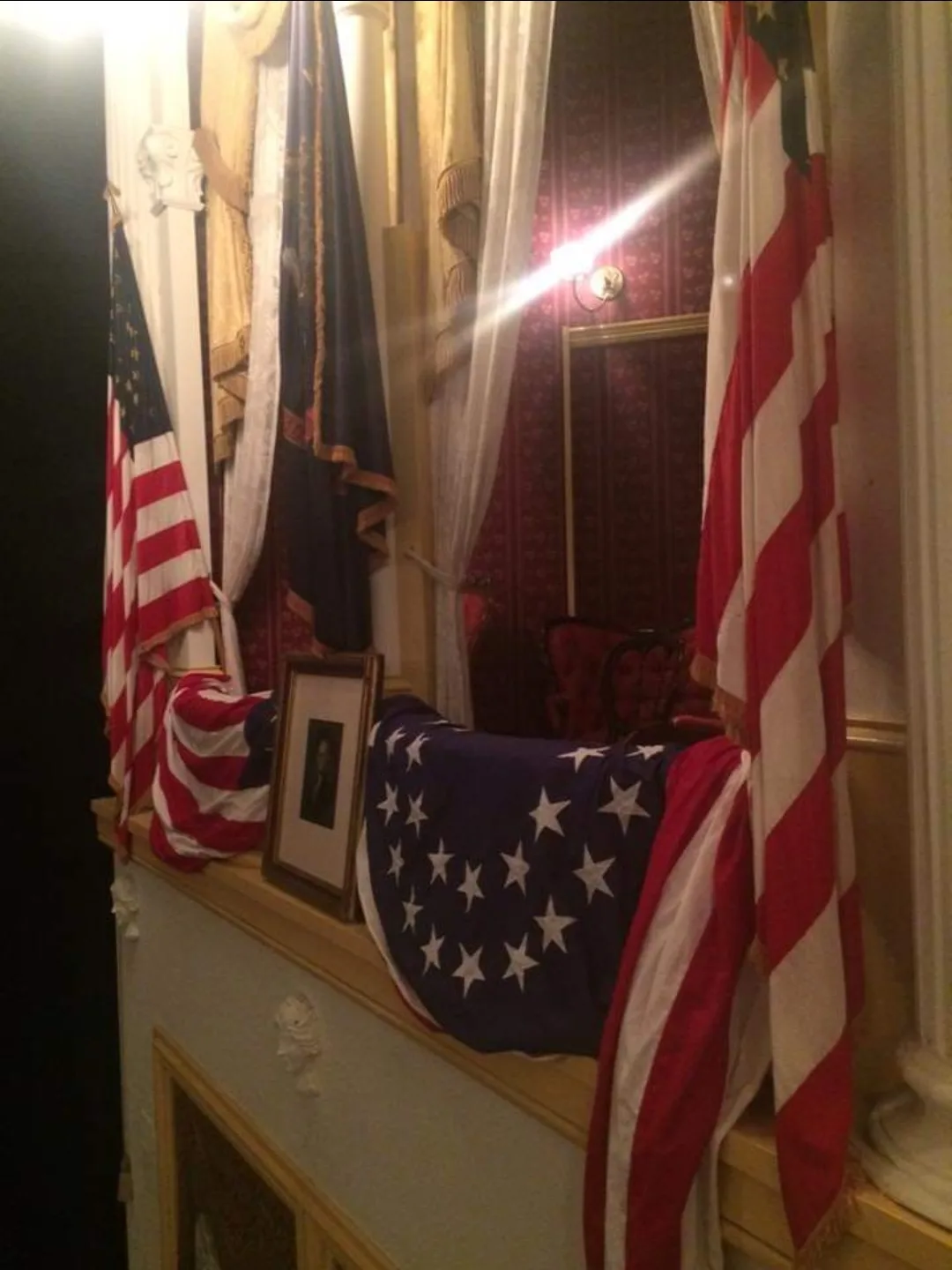
Why we thought visiting Washington DC in July was a good idea, I don't know, but we did! While in DC, we saw all the major sites--the Vietnam War Memorial, the Abraham Lincoln Memorial, and the Washington Memorial are pictured here, alongside our stop at Ford's Theater. We also stopped the White House and the US Capitol Rotunda. And we did it all while drenched in sweat from the humidity!
2015- The American Civil War Museum/White House of the Confederacy, Richmond, Virginia, United States of America
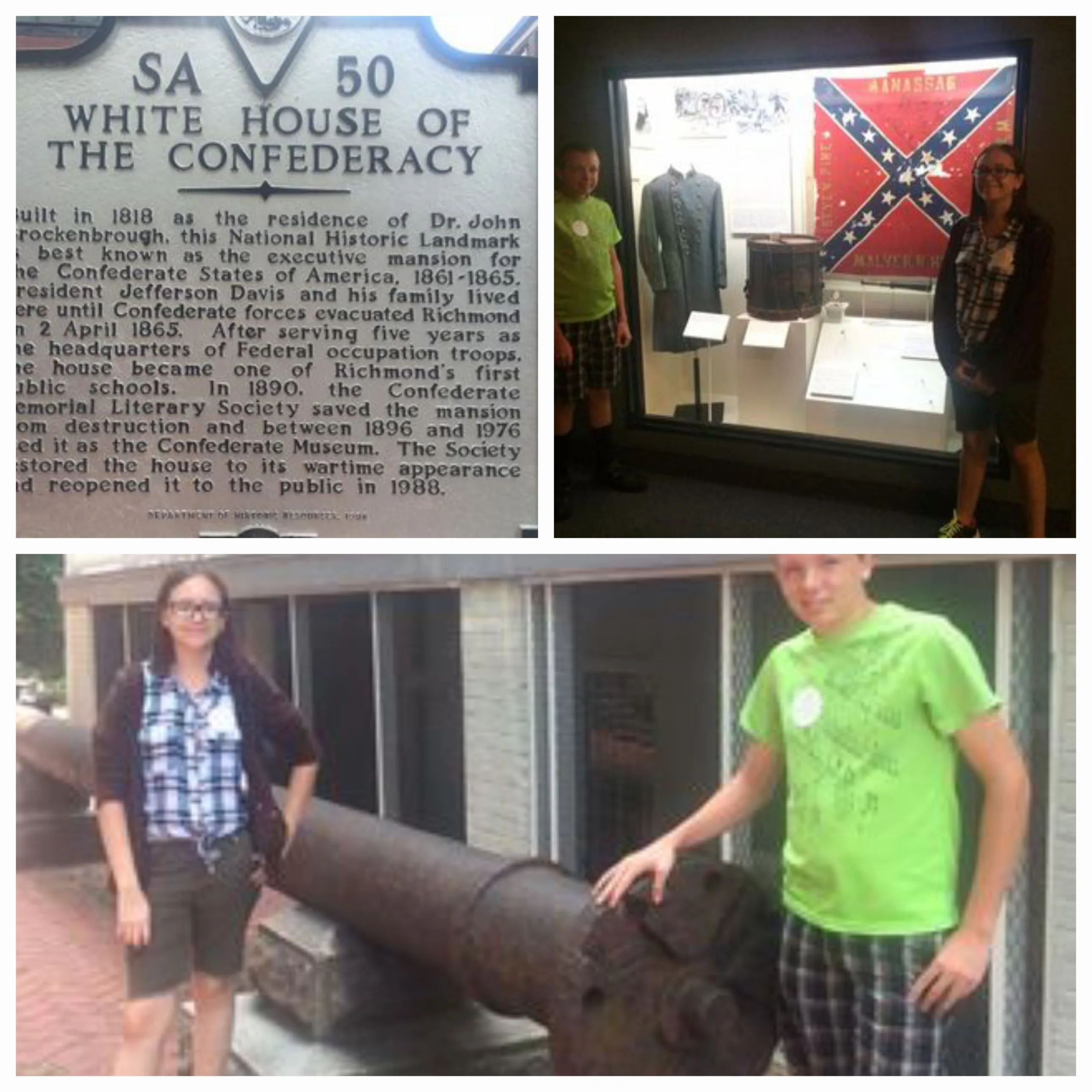
A little known historical place to visit is located in Richmond, Virginia. "The White House of the Confederacy" is exactly what it sounds like, the executive mansion and home of President Jefferson Davis and his family during the War Between the States.
Today, the home is open for tours, which my dad, brother, and I went on. Attached to the house is a museum dedicated to taking a more nuanced take on the War Between the States, which was also very interesting. To learn more about both the house and the museum, visit their website here.
2015-The Mariner's Museum, Norfolk, Virginia, United States of America
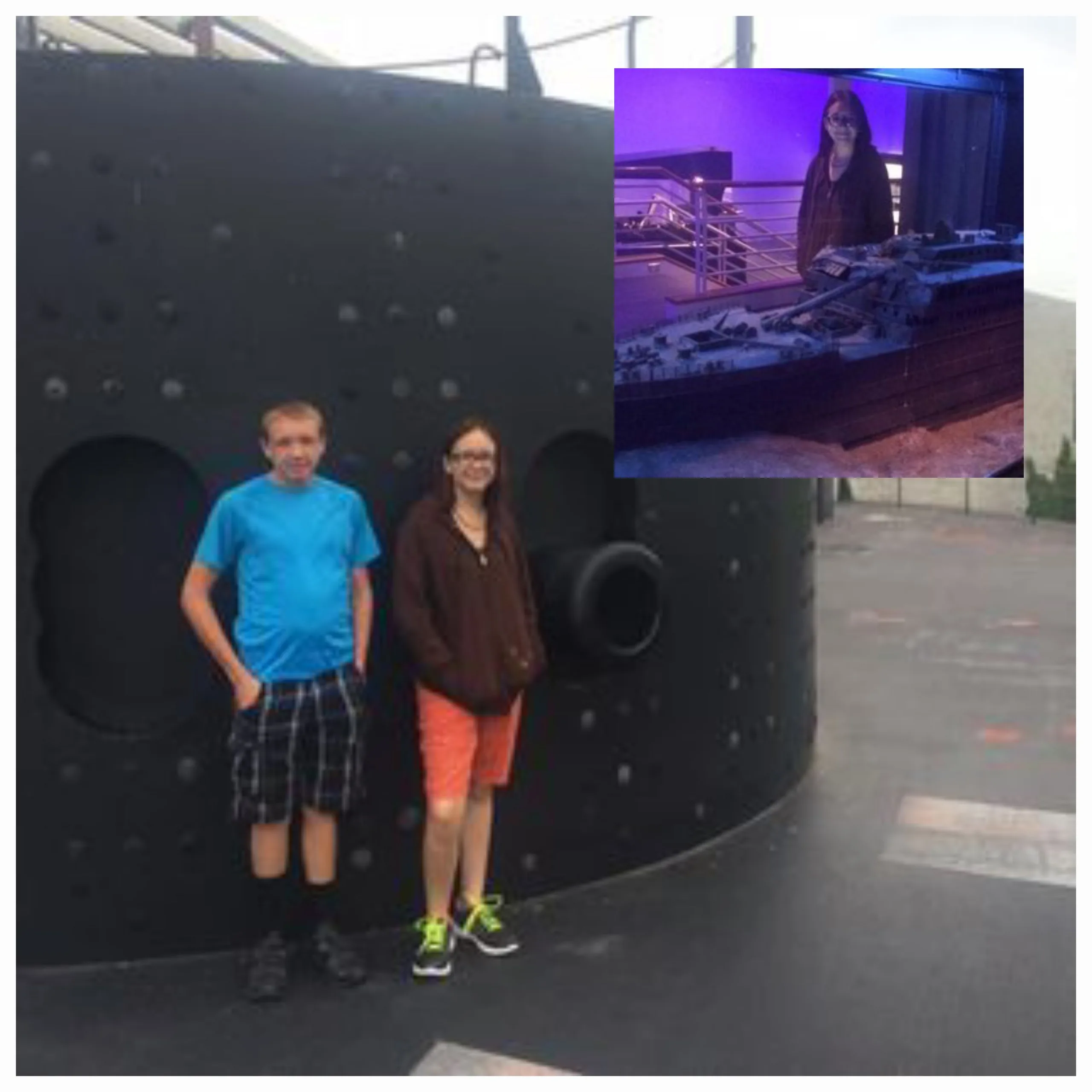
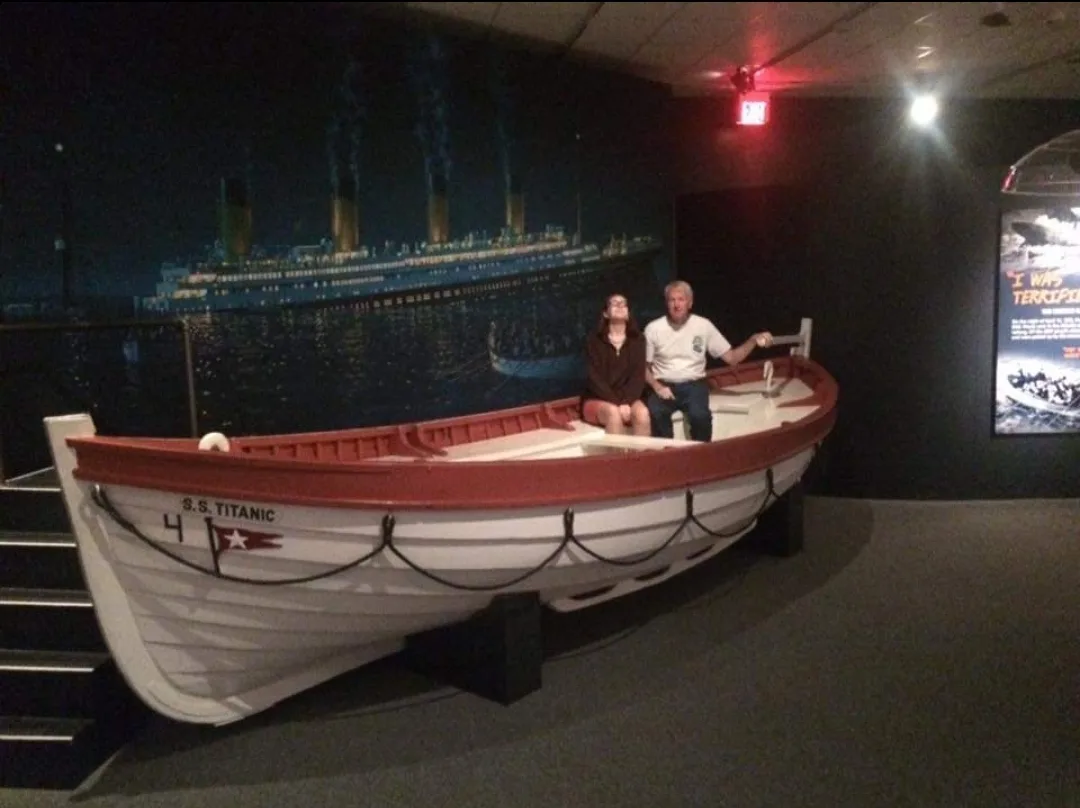
While we may have traveled to the east coast to celebrate my brother's birthday, my dad told me I could pick a few museums I wanted to see myself. Number one on my list was the Mariner's Museum in Norfolk, Virginia. The reason? My favorite battle to research from the War Between the States happened extremely close by, the Monitor vs the Merrimack, the world's first ironclad battleship battle.
Not only is the museum extremely close by to the battle location, but, the museum also holds the recovered pieces of the Monitor itself, which was lifted from the sea floor in 2002 and brought to the museum for preservation.
The museum dates all the way back to 1930 and remains open to this day. Also included in the museum are other artifacts and exhibits, including those from the RMS Titanic.
To learn more about the museum, visit their website here.
2016--Visiting Old Ironsides, also known as The USS Constitution, Boston, Massachusetts, United States of America
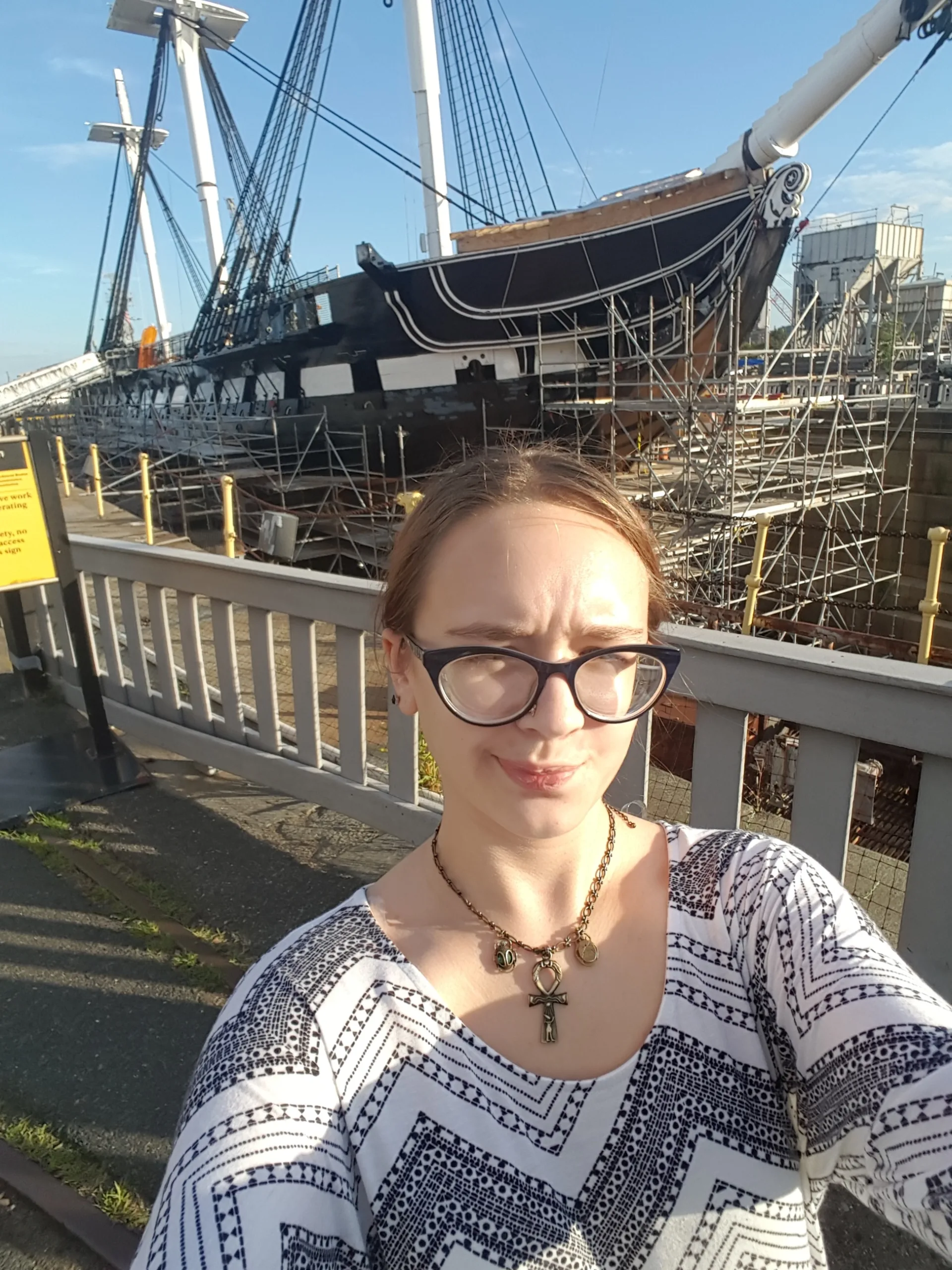
When I was sixteen, my dad and I took a trip to Massachusetts, New York, New Jersey, Vermont, New Hampshire, Connecticut, and Rhode Island. We landed in Boston, and unfortunately the museum for the USS Constitution had just closed for the day! So while I did not get a chance to go into the museum, I did get this quick selfie with the ship herself.
For those who do not know her history, the USS Constitution was designed and built between 1794 and 1797. Yes, you read that right, 1797.
The Constitution was one of six frigates created under the order of President George Washington, in order to create the fledgling United States' first true navy. It took three launches before she finally became truly seaworthy, and in 1798, the Constitution completed her first long-distance journey, sailing all the way to the Caribbean islands. Over the next thirty-two years, the ship would see battle in several conflicts along the Eastern Seaboard and garnering fame as she did so.
In 1830, rumors began to swirl that the Constitution would be scrapped. As a rallying cry to save the aging ship, Oliver Wendell Holmes Sr wrote a now-famous poem defending the ship, by-then nicknamed "Old Ironsides." This poem and public interest helped ensure the Constitution would survive being decommissioned and scrapped.
Between 1844 and 1846, the Constitution completed a sailing journey around the world. In all, she sailed 52,370 miles during that one journey.
By August of 1860, the Constitution was removed from active military duty and transformed into a naval school ship instead. To be fair though, by then the ship had been rebuilt several times and was sixty-three years old!
For the next several decades, the ship would serve as a training vessel for naval academy students as well as a transport vessel. In 1925, schoolchildren across the country would raise $154,000 in order to facilitate the latest round of restoration work for the ship.
In 1976, the USS Constitution Museum officially opened in the Charlestown Navy Shipyard. That same year, a group of white oak trees in Indiana are specifically set aside and designated for future repairs the ship might need.
In 1995, a copper spike from the ship went to space on a mission on the space shuttle Atlantis! Two years later, the Constitution would set sail under her own power for the first time in 116 years. She celebrated her 200th birthday in 1997.
All of these dates were provided by the official USS Constitution timeline posted on the museum's website, located here.
As you can see from my photo, when I visited the ship she happened to be undergoing her latest round of renovations, hence the scaffolding all over her. But even though I didn't get to spend as much time with the ship as I would have liked, it was still really cool to see a piece of history almost as old as the United States itself.
2016--Springfield Armory National Historic Site, Springfield, Massachusetts, United States of America
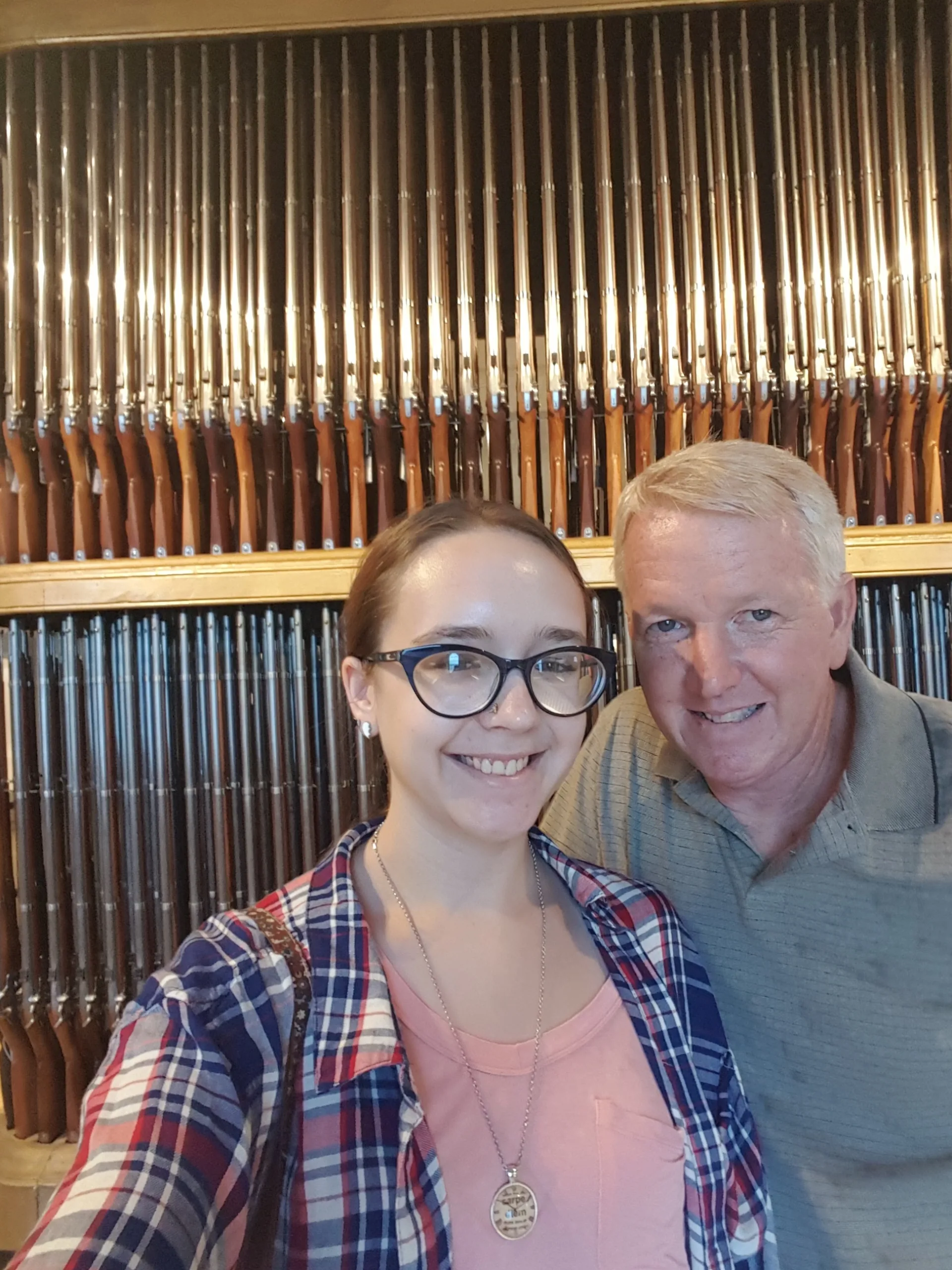
I think everyone knows the best adventures are the ones that happen on accident.
During my dad and I's trip back east, during which time we saw the USS Constitution, we also visited Springfield Armory, by accident.
We were driving along the freeway through Massachusetts when my dad pointed to a brown road sign on the side of the freeway.
"Springfield Armory!" he shouted excitedly before quickly changing lanes and exiting the freeway.
"What's Springfield Armory?" I remember asking him confused.
Little did I know, Springfield Armory is a hidden National Park that not enough Americans know about. I knew I had found a special place to hold in my heart when the first park ranger we met quickly introduced himself and then said:
"If you have any questions I will be right back! I left my car windows down and its about to rain. Be right back!"
Then he ran out the door we had just walked through, jingling his car keys as he went!
Springfield Armory began manufacturing muskets in 1794, but dated back a few years earlier, to when General George Washington declared it as a holding arsenal for the Revolutionary War Soldiers. The last weapons manufactured at Springfield Armory were produced in 1968, after two hundred and four years of continual manufacturing. Let me restate in case you missed it the first time--204 YEARS.
In 1978, Springfield Armory reopened as a National Historic Site, continuing to provide educational materials to guests to this day. The Armory holds the world's largest collection of American military firearms. To learn more about the armory, visit their website here.
2016-- 9/11 Memorial in Jersey City, New Jersey, United States of America
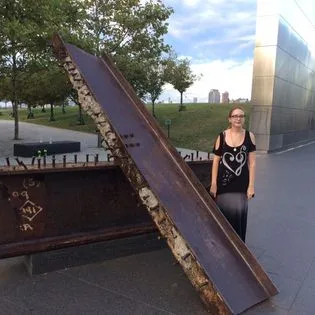
While on the same trip to New England with my dad, we stopped at multiple places in Manhattan, but also stayed at a hotel in Jersey City.
No offense New Jersey, but that was the most disgusting hotel room I have ever stayed in.
Anyway! While on that side of the river, we also stopped at the 9/11 Memorial, which was one of the most haunting and moving spots I have ever visited. Here I am standing alongside some of the rubble taken from the site of the Twin Towers.
2016--Ellis Island and the Statue of Liberty
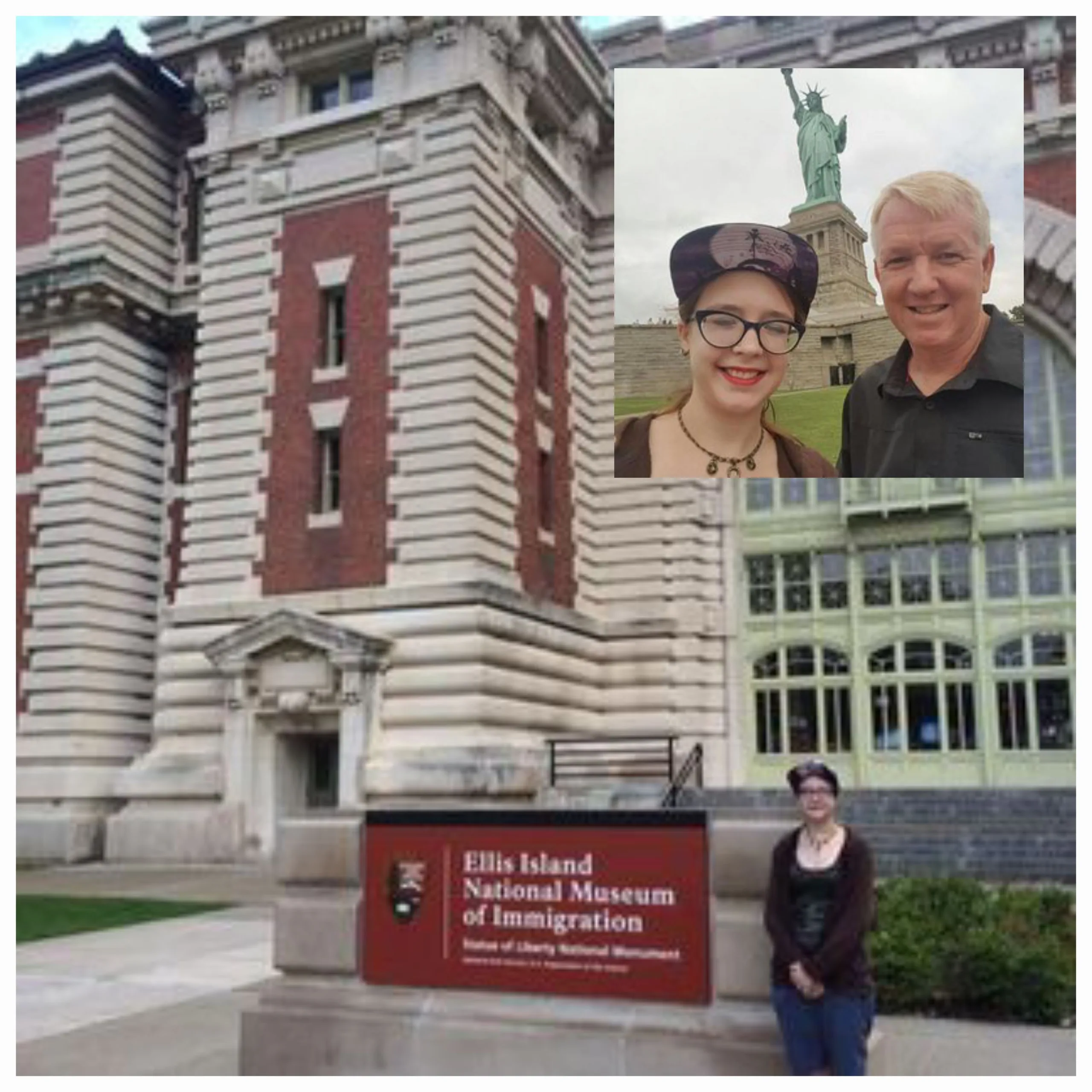
Once again I must apologize for my awful sense of fashion. I was sixteen and...well there's really no excuse for why I thought that was a good look. I also chose to wear extremely uncomfortable shoes and so I was miserable most of the day we were hiking around Manhattan, Ellis Island, and the Statue of Liberty.
With all that said, I did really enjoy the day, which started at Ellis Island.
For those who do not know, Ellis Island and the Statue of Liberty are both operated as part of the same national monument, which has been dubbed the "Statue of Liberty National Monument, NJ, NY" according to the park's website, which can be accessed here.
Ellis Island was operated as an immigration checkpoint for the Eastern United States between 1892 to 1954. During those years, over twelve million immigrants traveled the halls of Ellis Island to be inspected, both physically and on paper, before they were told whether or not they would be allowed to travel within the United States.
In 1965, Ellis Island became a part of the Statue of Liberty National Monument, as I mentioned above. Between 1976 and 1984, the island was opened to tourists wanting to visit, however, it was badly in need of repairs. $156 Million later, the island reopened for tourists in 1990, and has remained open ever since.
As for the Statue of Liberty, she has a history of her own.
The statue was first gifted to the United States by the people of France in 1886, and was designated a national monument in 1924. The National Park Service began caring for the statue in 1934, and today hundreds of tourists flood the island each and every day to get photos like my dad and I posed for.
You can make reservations to travel up inside the statue itself, all the way up to her crown, but my dad and I didn't have the time nor did we want to battle our way through the crowd either. To learn more about the statue or to plan a trip, you can visit the National Park Service website for the statue here.
You can reach both Ellis Island and the Statue of Liberty by a ferry. My dad and I embarked on our journey from New Jersey, and ended up in Manhattan where we continued on as tourists for the day.
2016- The Metropolitan Museum of Art, Manhattan, New York, United States of America
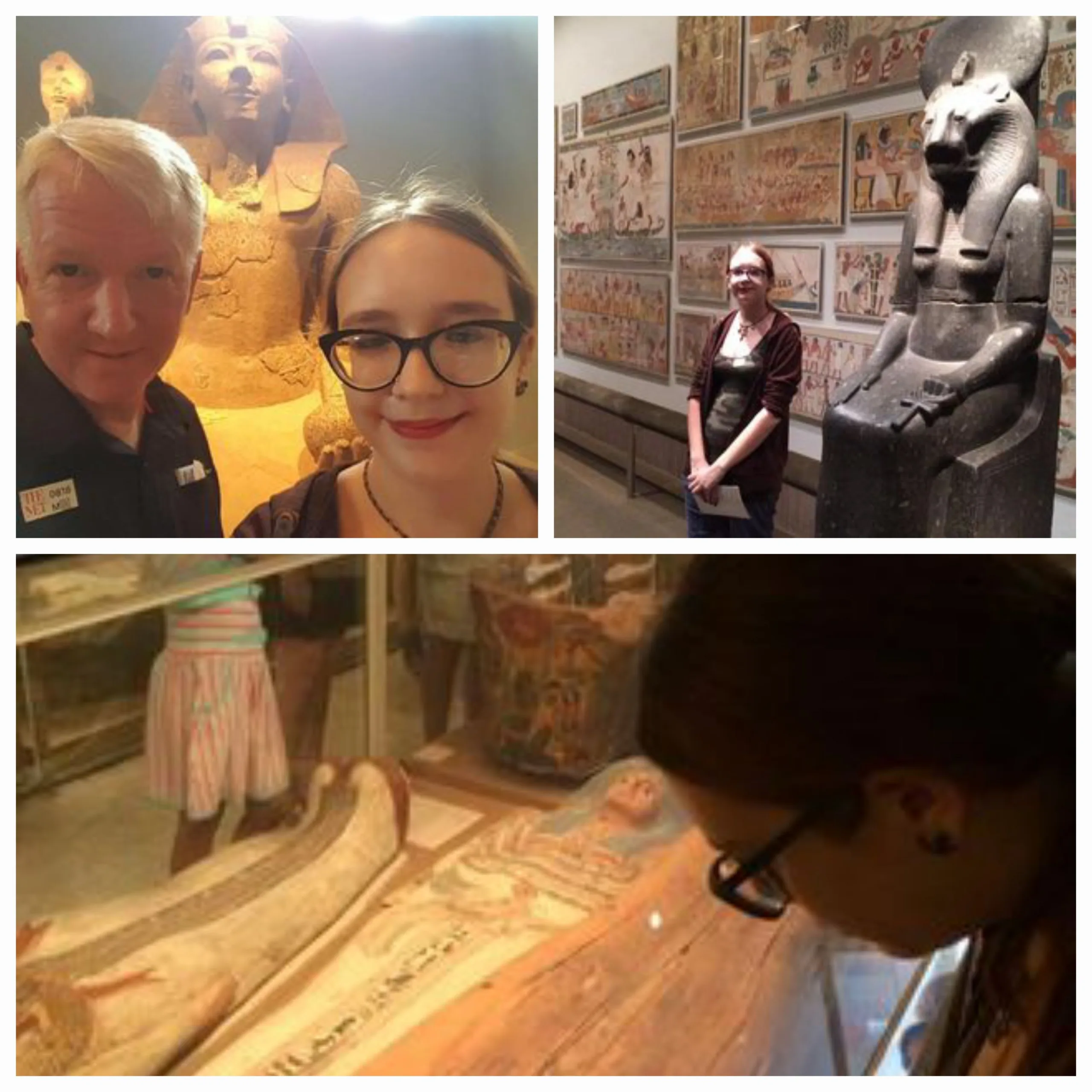
Ah, the Met. One of the most well-known art museums in the world, thanks to celebrity functions like The Met Gala that happens every year.
When I visited the Met, my dad and I were in a bit of a hurry, so we didn't get to see the entire museum. We did, however, spend a large amount of time in the Ancient Egypt wing. I don't have a photo of it here, but my favorite artifact in the entire Met was the actual floral wreath that was placed over Pharaoh Tutankhamun's mummified remains.
The history of the Met begins in 1866, when a group of Americans in France decided to bring art and art history to the United States in order to better educate the American public. In 1870, the Met officially opened its doors on Fifth Avenue, however it was a different Fifth Avenue location from where it is today. The museum would not open at its current site until 1880.
To learn more about the Met and its various collections that are on display, visit their website here.
2017- Tortilla Flat and Hayden, Arizona, United States of America
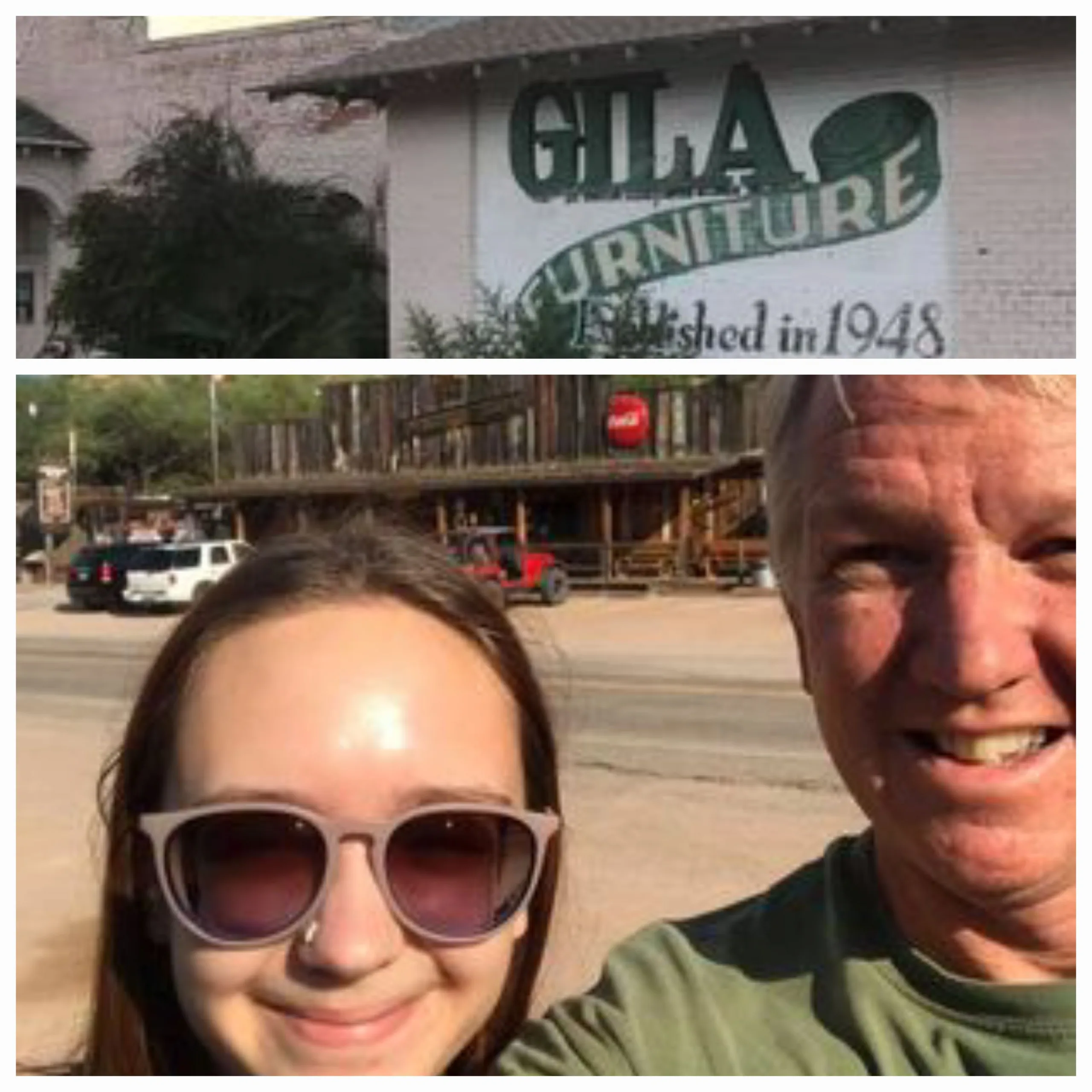
When I was seventeen, my dad and I both decided I should probably learn to drive. A right of passage for most American youth, I already owned a car (I had bought a 1999 Mercury Grand Marquis from a friend of the family when I was fourteen for $2,000), and so all I needed to know was how to drive it.
You would think learning to drive would be fairly straightforward, and for a lot of teenagers it is. For me though? Not so much. For those who do not know their late 90s vehicles, my car was basically a boat. Picture a 90s police car--that's basically what I was driving just without the red and blue flashing lights.
And if you also don't know, I wear glasses and have extremely poor depth perception. So when it came time for me to learn to drive, my dad and I were in for a bit of adventure.
Most Arizonans living in the eastern half of the Valley of the Sun know exactly what Tortilla Flat is, but if you're an out-of-towner, I'll let you in on a little secret. Tortilla Flat is a tourist spot but is also the oldest still-operating stagecoach town in the state of Arizona, originally built in 1904. They even have a website, which you can access here.
Today, Tortilla Flat has a restaurant, a museum, and a gift shop. If you've driven into town, you've seen it all, but its still worth it to park and wander around for a bit. In order to get to Tortilla Flat, you have to drive along a long and winding road...with several cliffsides along side it.
If you ask my dad, he will heartily inform you that I nearly drove off several of those cliffs while learning to drive. In my defense! I had no idea where we were going at the time. My dad had me sit behind the wheel, and drive. He was giving me directions as we went. Luckily we didn't die! Or drive off a cliff! And now its a funny memory to look back on.
That same day, after leaving Tortilla Flat, we continued on our little road trip and headed out to Hayden, Arizona. If you've never heard of Hayden don't worry--I hadn't either. The town still has a few residents, but most of the buildings are abandoned. We drove out there because my dad used to sell furniture to a store out there called Gila, shown here, which opened in 1948. Hayden may be tiny, but they do still have an active website, which you can reach here.
2017-- Lincoln, New Mexico, United States of America
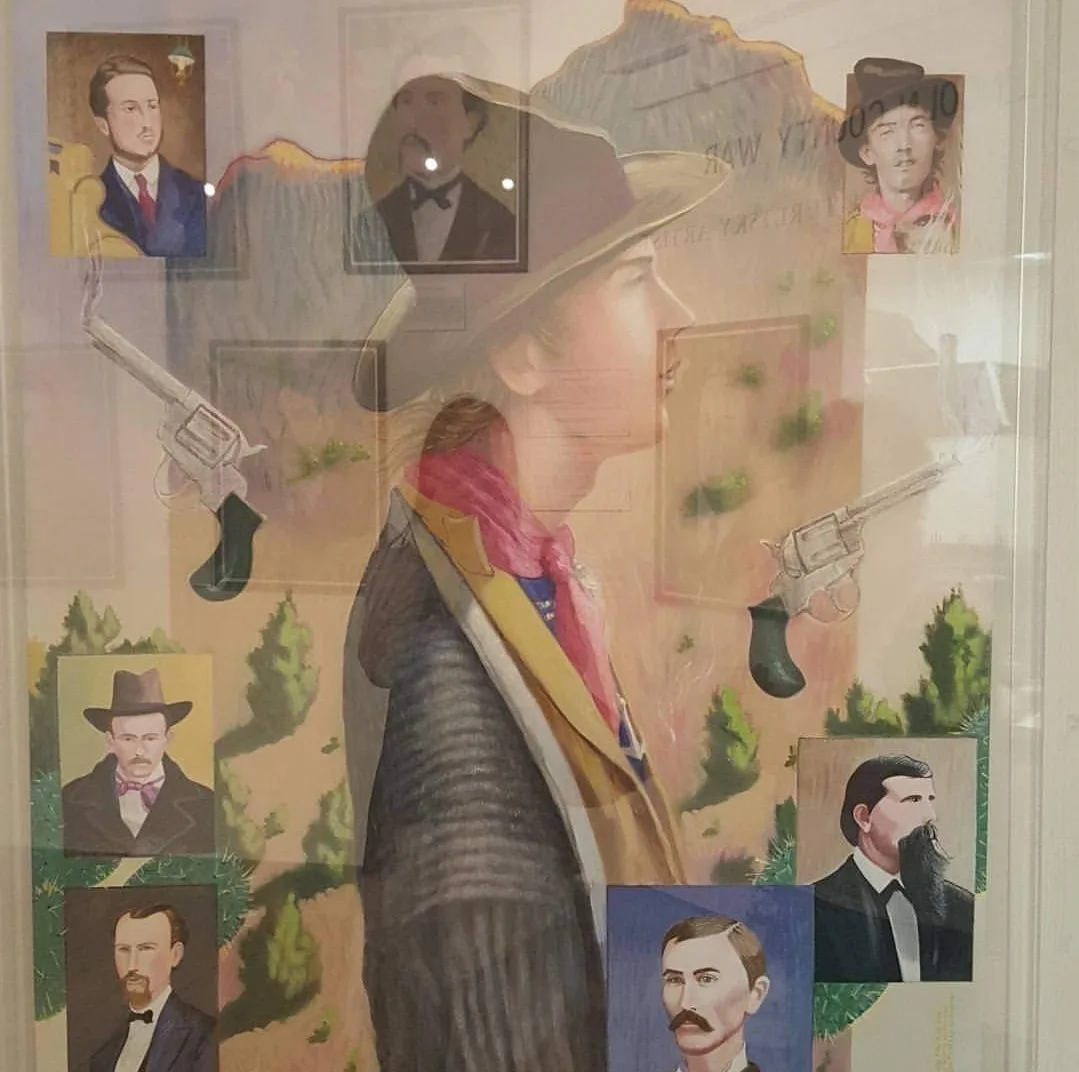
I can't believe this is the only surviving photo I took of my trip to Lincoln! While not much survives in Lincoln today, the tiny town was once the sight of one of the nastiest wars in the Old West, The Lincoln County War. And you know who the most-famous character to walk away from that war was?
Billy the Kid.
The Lincoln County War is a story that deserves a fully fleshed out retelling, which I don't have space for here, but the war took place because of local politics and street-vengeance. Some of the battles took place on the very streets tourists can now walk every day.
According to the Lincoln Historic Site website (which you can reach here), the little town is now the most-visited historic site in New Mexico. There are multiple buildings that have survived from the 1870s and 1880s, as well as gift shops and museums tourists can visit. This photo is of a painting of Billy the Kid and some other notable western figures involved in the local history at the time.
If you're ever passing through Southern New Mexico, I highly recommend stopping by Lincoln. Ruidoso, New Mexico is a short drive away and has beautiful sights and hotels to stay in. Another random fact--if you're in a rental car that does not have Bluetooth or an Aux Cord, you can tune into the local classic rock station, KIDX 101.5 "The Kid" named in honor of the area's most famous outlaw.
2017- Montezuma's Castle, Toozigut, Fort Misery, and Jerome, Arizona, United States of America
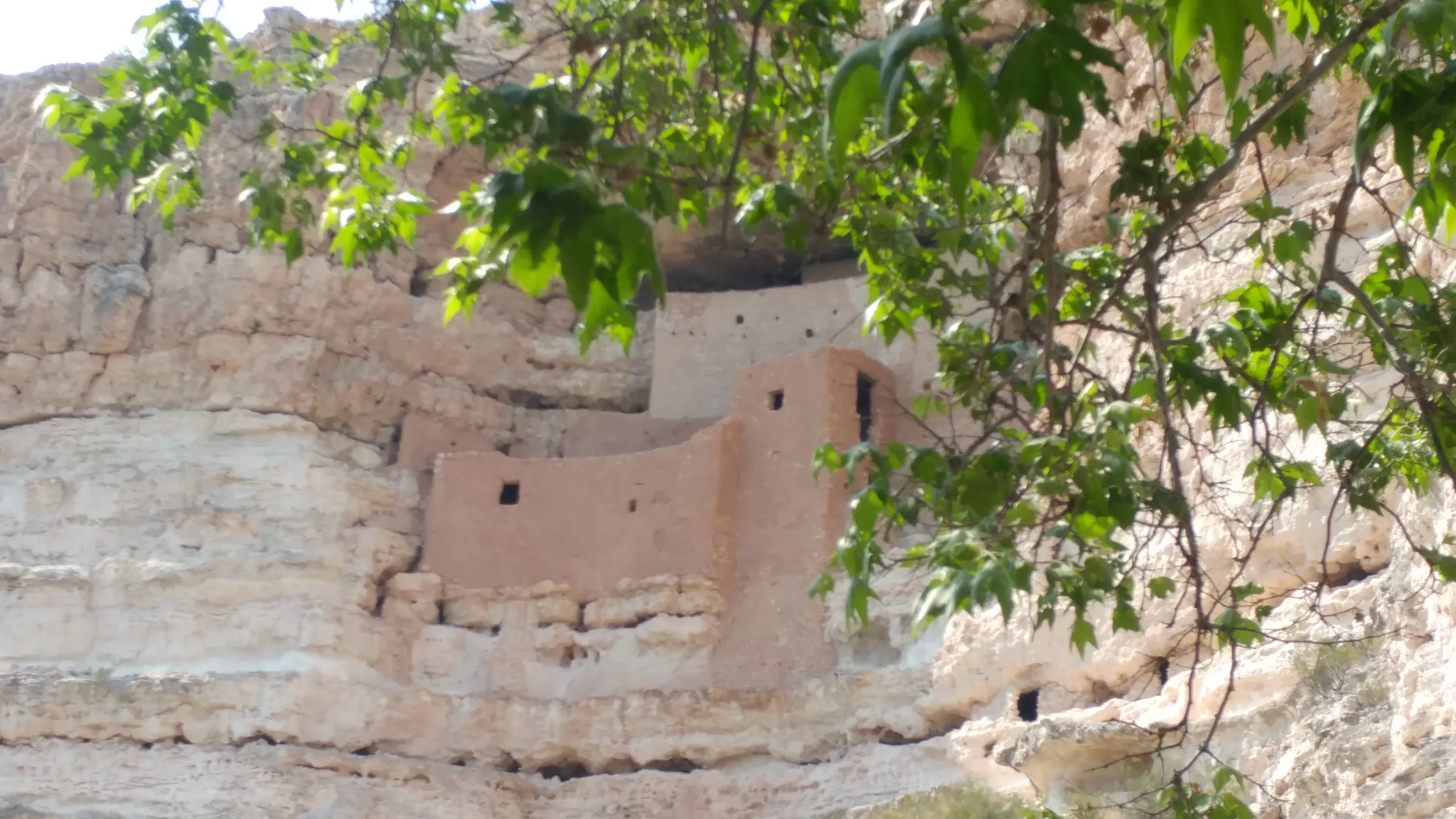
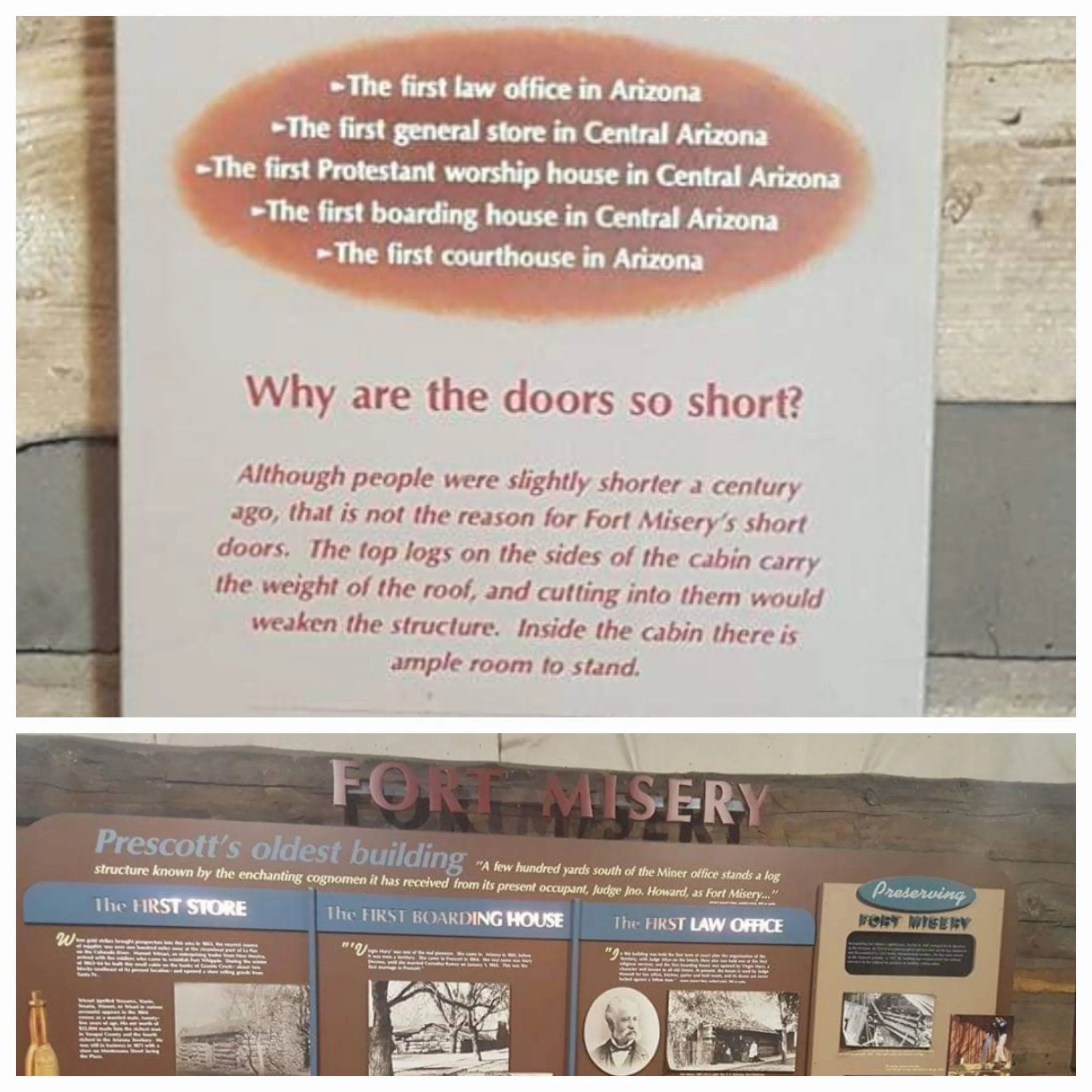
At one point in 2017, my mom and I took a road trip around the area of Prescott, Arizona--unfortunately not many pictures of this trip survive. While we were driving around, we visited Prescott and Jerome, Arizona, as well as national monuments like Toozigut and Fort Misery.
I have actually visited Jerome three or four times throughout my life, but I don't have any photos somehow! So that's disappointing, but yes, Jerome holds a special place in my family's heart. Jerome has been dubbed the "Wickedest Town in the West" according to the town's website (which can be accessed here). Originally founded in 1876, Jerome eventually became the fourth largest city in Arizona, with a population of around 15,000 people in the 1920s. This number is incredible given the fact that the town is literally built into the side of a hill, and constantly looks like its about to collapse and fall.
No I am not kidding.
The population today has shrunk to around 400 people, but its a thriving tourist spot and has a major scene in the art world, alongside its close-by neighbor Sedona.
To learn more about Jerome here on my website, you can read articles on its most famous Madam, Jennie Bauters, as well as the town's strange connection to Winston Churchill through his mother, Lady Randolph Churchill.
Fort Misery, on the other hand, has been deemed the oldest still-surviving log building in the state of Arizona. Originally built in either 1863 or 1864, today the log cabin has been moved from its original site to now being a part of the Sharlot Hall Museum (which you can read more about here). My takeaway? The doors were really, really, short.
Because no trip around Arizona would be complete without visiting Native American sites as well, my mom and I also stopped at Montezuma's Castle, pictured above, and Tuzigoot National Monument.
Best estimates from archaeologists date Montezuma's Castle to around 600 years ago, when the Sinagua people called it home. Built into the side of a cliff, Montezuma's Castle is a pueblo ruin comprising of over forty ruins. Archaeologists theorize that the Sinagua people lived in and around Montezuma's Castle for four hundred years.
The site was one of four national monuments created in 1906 by President Theodore Roosevelt, making it one of the oldest historic landmarks to be declared a national monument in the United States.
Early visitors could actually step foot inside the ruins thanks to scaffolding ladders that had been erected on the cliffside, but extensive damage to the ruins by tourists eventually made it so that the public was no longer allowed access after 1951.
The closest visitors can get today is from where I took the photo you can see above. The reason why it is so fuzzy is because I had to zoom in quite a bit on my phone's camera. While its disappointing that we as the general public can no longer get closer, at least the site will be preserved for generations to come.
To learn more about Montezuma's Castle, you can read about it on the park's website here.
As for Tuzigoot National Monument, this pueblo structure holds over 100 rooms inside and was occupied by several hundred people for several hundred years.
The site was abandoned by the Sinagua people sometime in the 1300s and was left abandoned until the 1930s. At that point, archaeologists excavated the site and in 1939 it was turned into a national monument. To learn more about Tuzigoot, you can read about it here.
I don't have any photos that survive from my time at Tuzigoot, but I did purchase one of the most interesting books in my entire collection while there, which is really saying something given the fact that I own almost 1300 books at this point.
The book in question is called Finder's Keepers: A Tale of Archaeological Plunder and Obsession by Craig Childs. Mr. Childs dives deep into the question of archaeological ethics, and whether or not archaeologists should remove artifacts from their ancestral homelands to display in museums and other places. The book made me question what I thought I knew about anthropology and the field of archaeology, and I highly recommend it to anyone with an interest in those fields, along with Southwestern Native American studies as well.
2018-- Sentimental Journey, again! Mesa, Arizona, United States of America
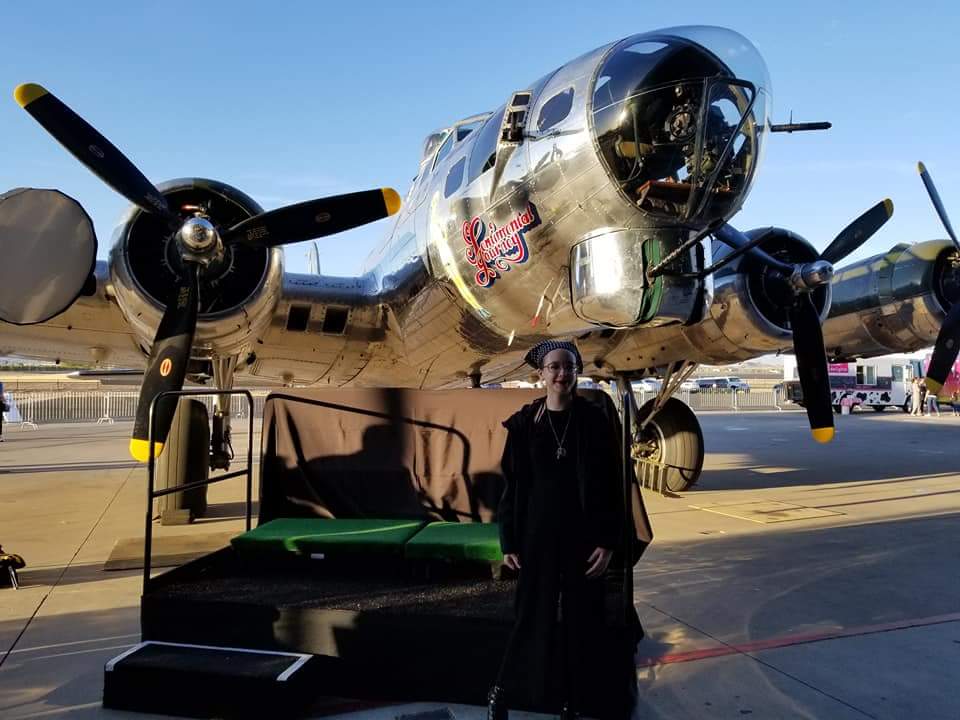
For my grandmother's 76th birthday, my mom, brother, and I took her to a big band swing dance that was a fundraiser for the Commemorative Air Force Museum. The main showstopper attraction was Sentimental Journey, so I posed for a photo with my old friend.
2019--Joining the Daughters of the American Revolution, Chandler, Arizona, United States of America

While this technically wasn't "visiting" a historic site, this is definitely a historic achievement.
The Daughters of the American Revolution are a genealogy based organization that hope to promote historic preservation, patriotism, and education. In order to join the society, you must be a woman who can prove direct lineage from a patriot who fought in the American Revolution.
Since DAR's founding in 1890, over one million women have become members, and I happen to be one of them.
To learn more about DAR, and see if you might be able to join and become a member yourself, visit the national website at dar.org.
2019--Visiting The Madonna of the Trail Statues in Albuquerque, New Mexico, and Springerville, Arizona, United States of America
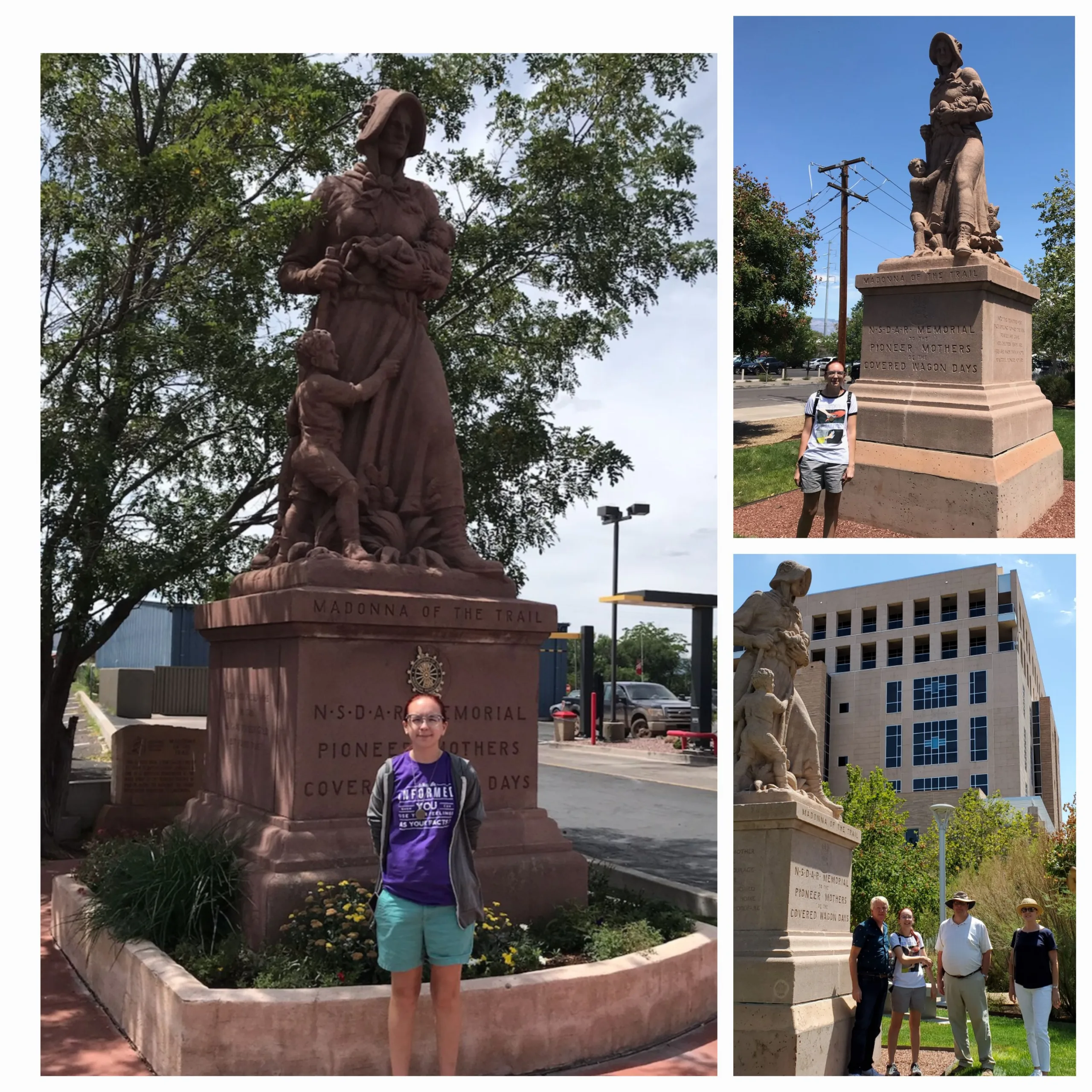
2019 was a big year for me and my DAR journey. A few months after joining the organization, I got the chance to visit two of the statues DAR erected across the United States, from Maryland to California.
The project began in 1911, when the national society decided to erect twelve identical statues across the "Old Trails Road" that stretched across the country. The first statue was dedicated in 1928, when then-judge (and future president) Harry S Truman spoke at the unveiling.
The twelve statues are located in the following locations:
-Bethesda, Maryland
-Beallsville, Pennsylvania
-Wheeling, West Virginia
-Springfield, Ohio
-Richmond, Indiana
-Vandalia, Illinois
-Lexington, Missouri
-Council Grove, Kansas
-Lamar, Colorado
-Albuquerque, New Mexico
-Springerville, Arizona
-Upland, California
I have personally visited the statues in Springerville, Arizona, and Albuquerque, New Mexico, and hope to one day visit some of the others as well. The statues were erected to honor the pioneering spirit of mothers along the old wagon roads across the country. Unfortunately today, some see the statues as problematic and take issue with them as a result, but so far, all twelve have remained standing.
To read more about the statues, and the controversy surrounding them, click here.
2020--Visiting Butte View/Adamsville Cemeteries, Florence, Arizona, United States of America
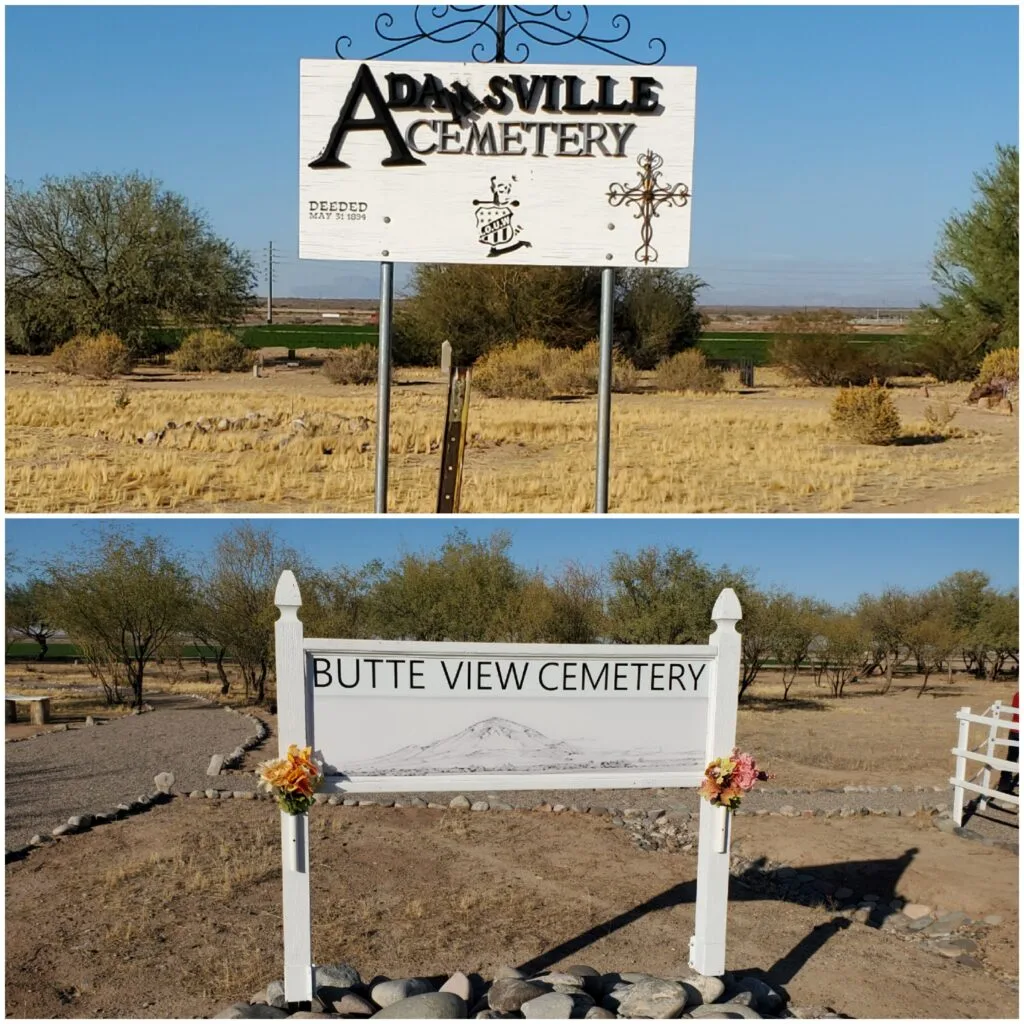
I won't spend much time on this section because I already wrote a blog post about these old cemeteries, which you can read here.
This is simply an acknowledgement that in late 2020, I visited these two adjoining cemeteries outside of Florence, Arizona.
2020--Visiting Historic Pinal Cemetery, outside Superior, Arizona, United States of America
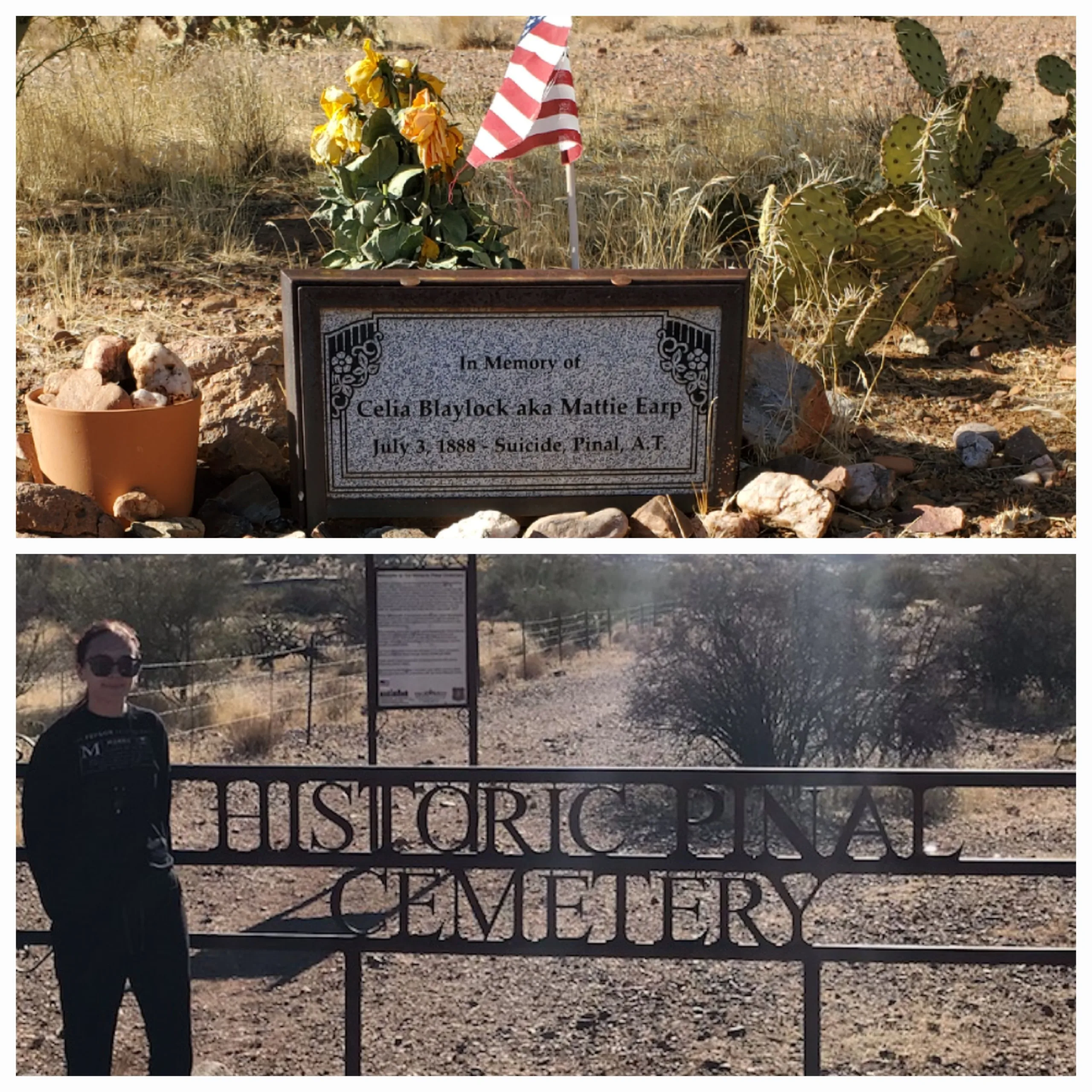
Once again, I already wrote a more extensive blog post about Pinal Cemetery, which can be read here.
I visited the abandoned cemetery in late December 2020, but my dad, brother, and cousin first visited in 2006 or 2007. Its way off the beaten path and hard to locate for those who have never visited before, but its still worth a stop if you happen to be in the area.'
2021--Boothill Graveyard, Tombstone, Arizona, United States of America
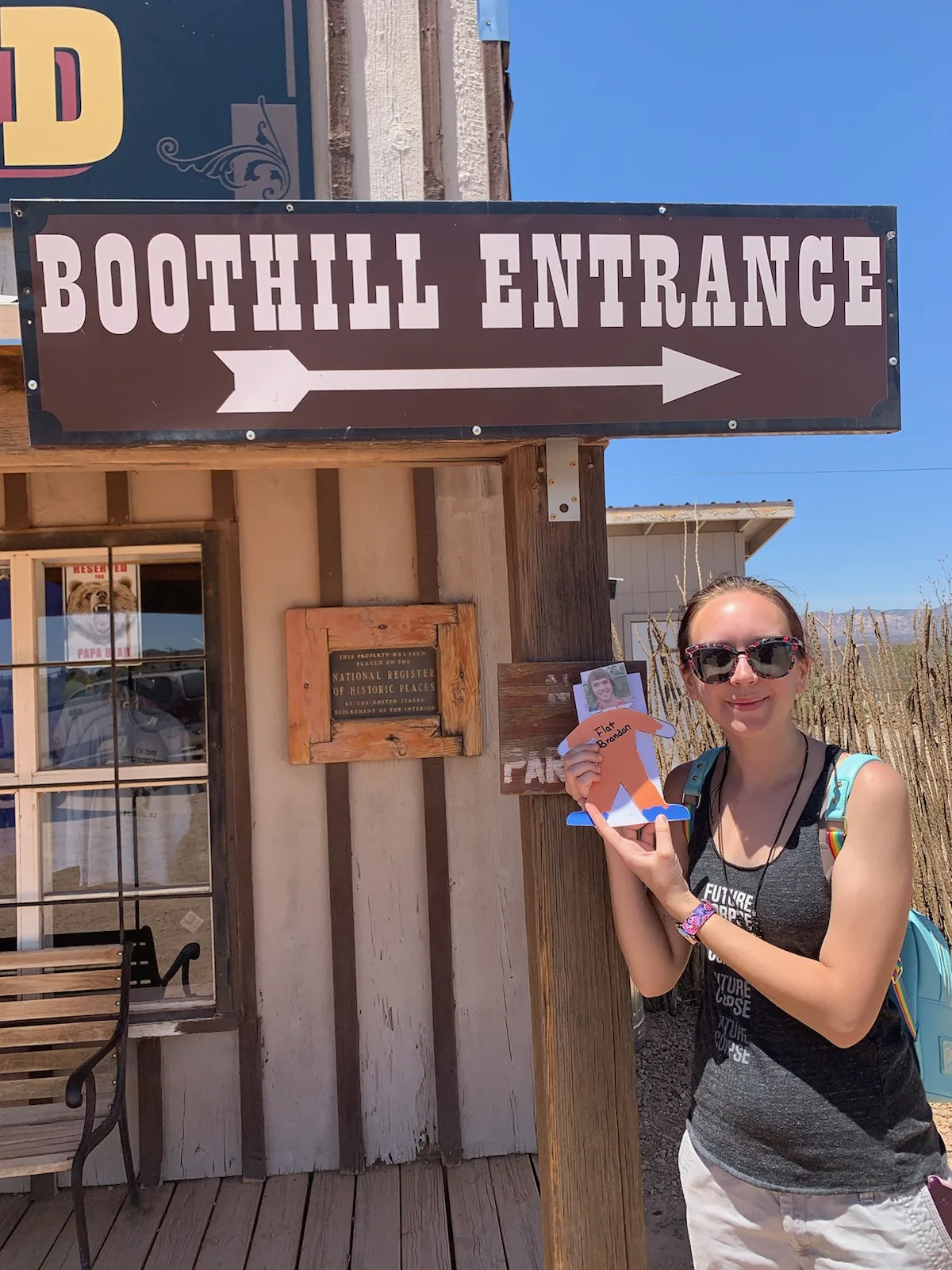
Once again, I already have a blog post written about my stop at Boothill, which can be read here. I've been to Tombstone twice now, and it is a lot of fun if you like old west tourist things! (Ignore the Flat Brandon, its a long story!)
2021--The Titan Missile Museum, Green Valley, Arizona, United States of America
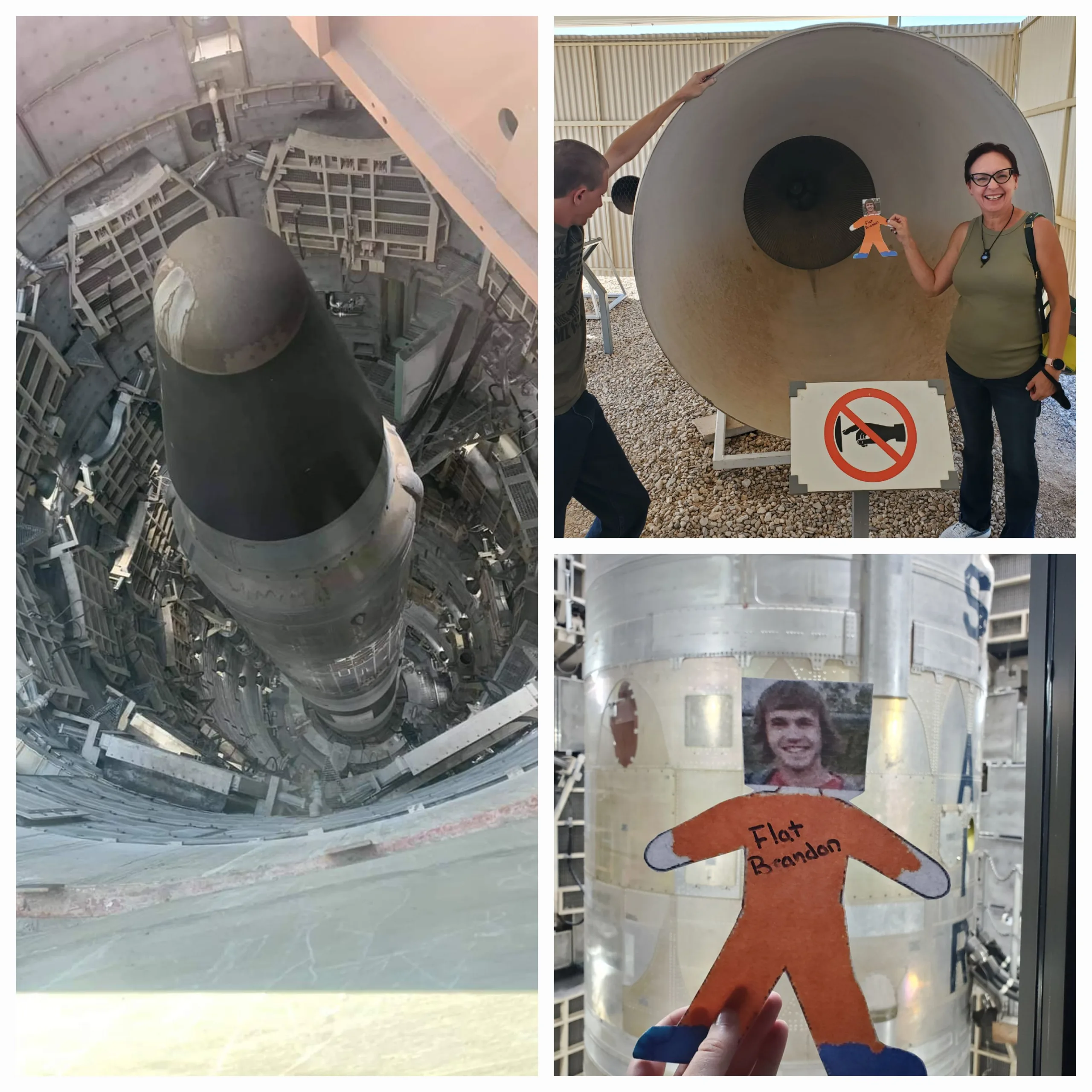
Do you like large and intimidating nuclear warheads? Do you enjoy smacking your head on metal scaffolding if you happen to be above five and a half feet tall? Do you like going up and down lots of metal stairs?
If you said yes to any of the above questions, do I have the museum for you!
Once again, no I'm not kidding!
The Titan Missile Museum is a de-activated nuclear missile silo that allows visitors to step inside a window into the past. There isn't a lot of information about the history of the site itself--I'm guessing because part of it might still be under lock and key from the federal government.
The Titan Missile Museum teaches visitors about The Cold War and the nuclear missiles developed during it, specifically the Titan II Missiles. Visitors get to see artifacts on the surface as well as traveling down into the silo itself. And don't worry, the photos of the missile shown here are real, BUT the missile has been deactivated and is not harmful to the general public.
To learn more about the museum and the Titan II missiles, visit their website here.
2021--Grand Canyon Pioneer Cemetery, Grand Canyon Village, Arizona, United States of America
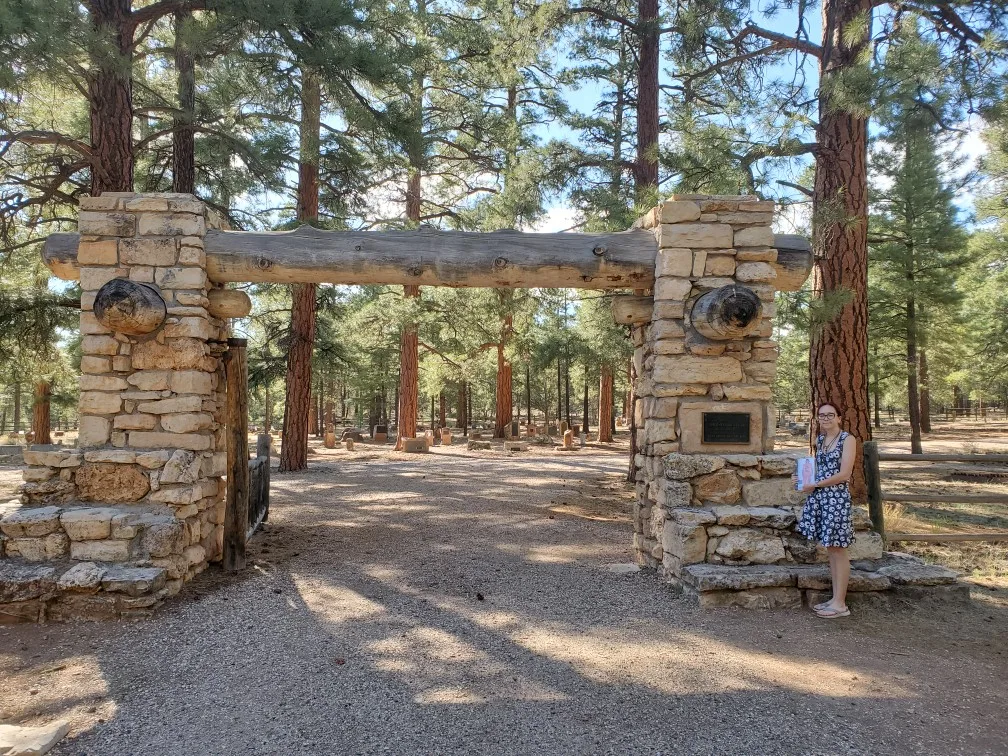
I also have a blog post about the cemetery at the Grand Canyon, which can be read here.
If you are ever visiting Arizona's most famous landmark, make sure to stop at the cemetery to see some of the most unique headstones I have ever seen.
2021--Philo Farnsworth Grave (Provo City Cemetery, Provo, Utah, United States of America) and Reva Beck Bosone Grave (American Fork Cemetery, American Fork, Utah, United States of America)
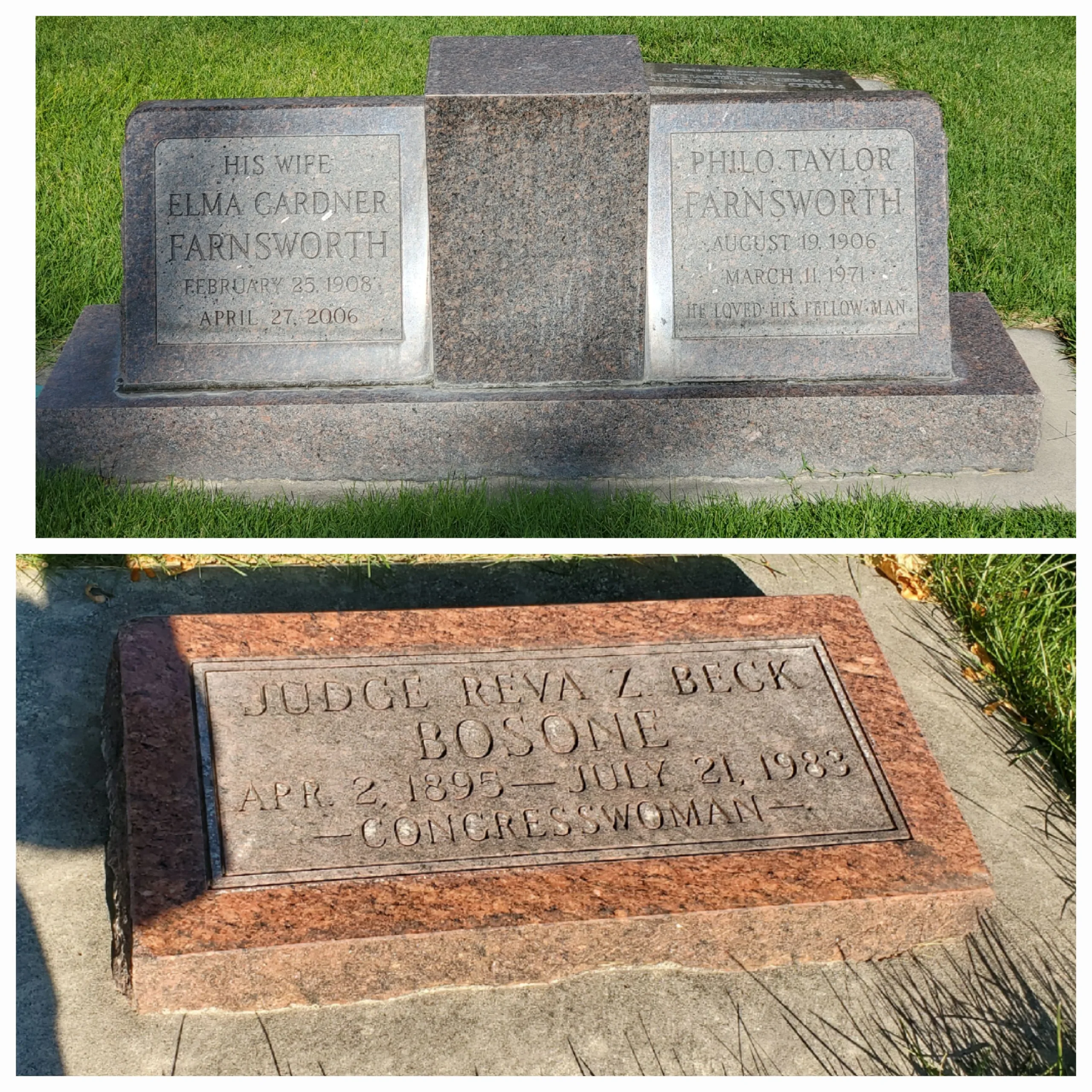
Once again, I wrote more extensively about both cemeteries in a blog post that you can read here.
If you would like to learn more about why I visited the two individuals I did, you can read about them both here:
Philo Farnsworth, inventor of the all-electric television
Reva Beck Bosone, first female politician elected to national office from Utah
2021--Sacagawea Cemetery, Fort Washakie, Wyoming, United States of America
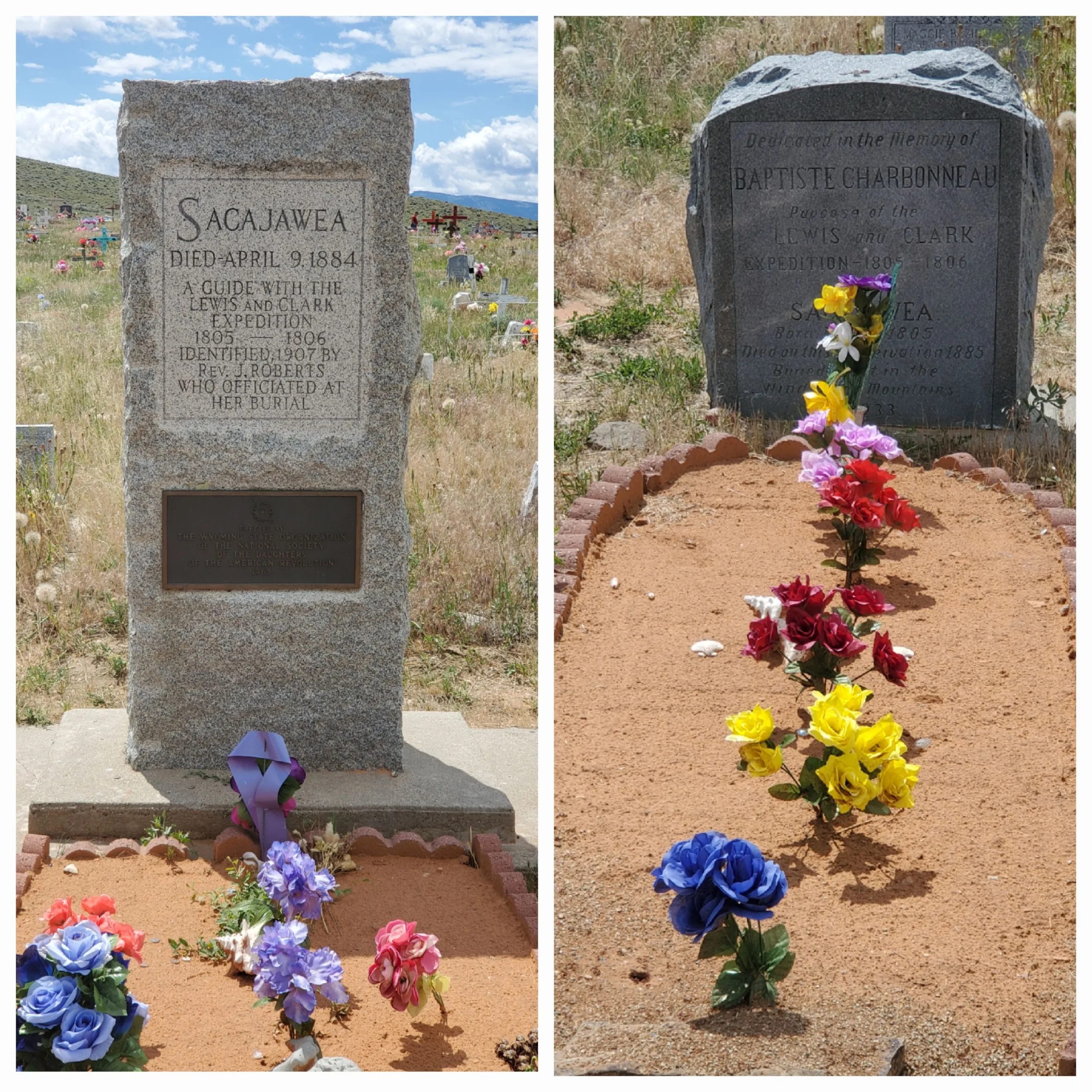
Once again, I have a more conclusive writeup on the cemetery that can be read here.
2021--The Buffalo Bill Center of the West, Cody, Wyoming, United States of America
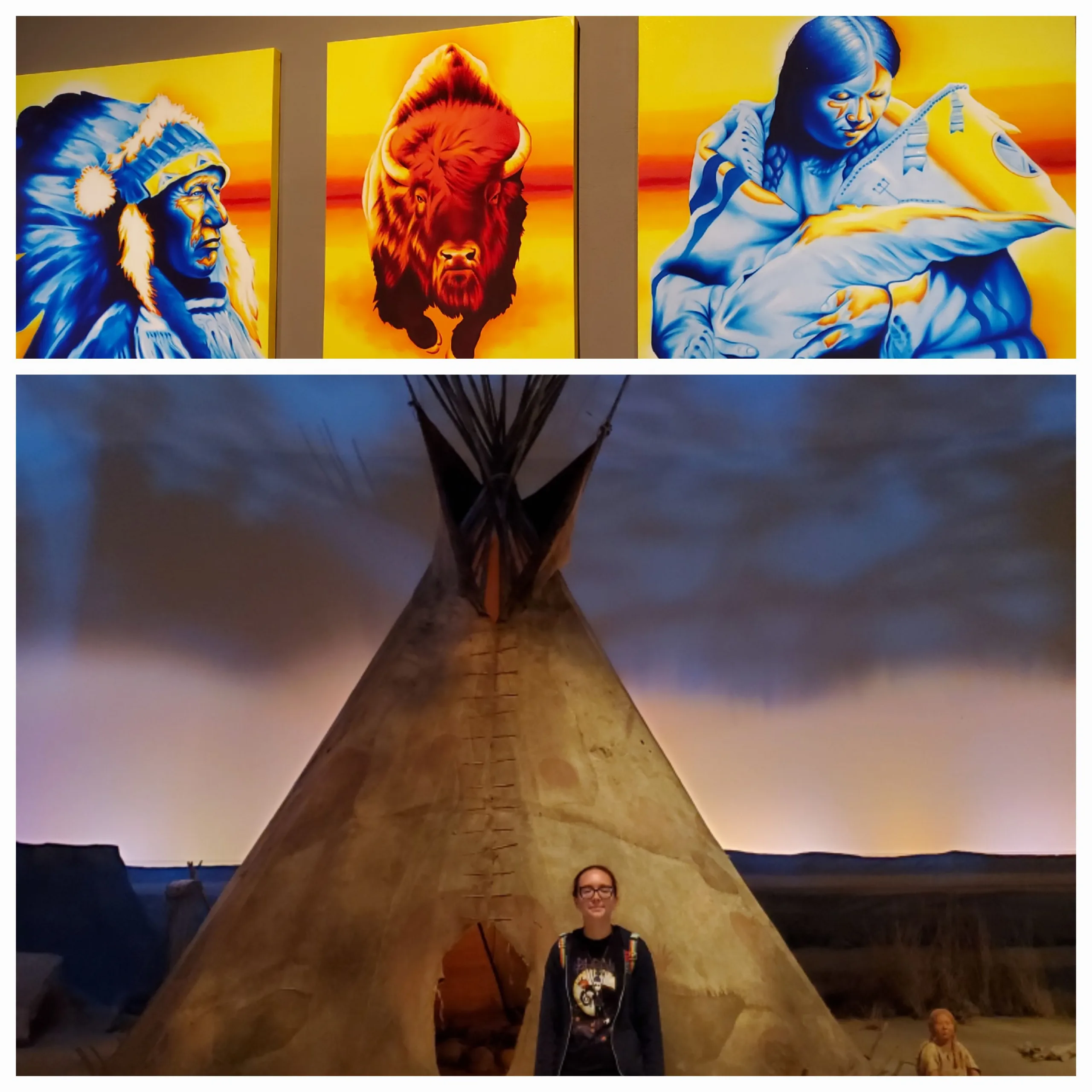
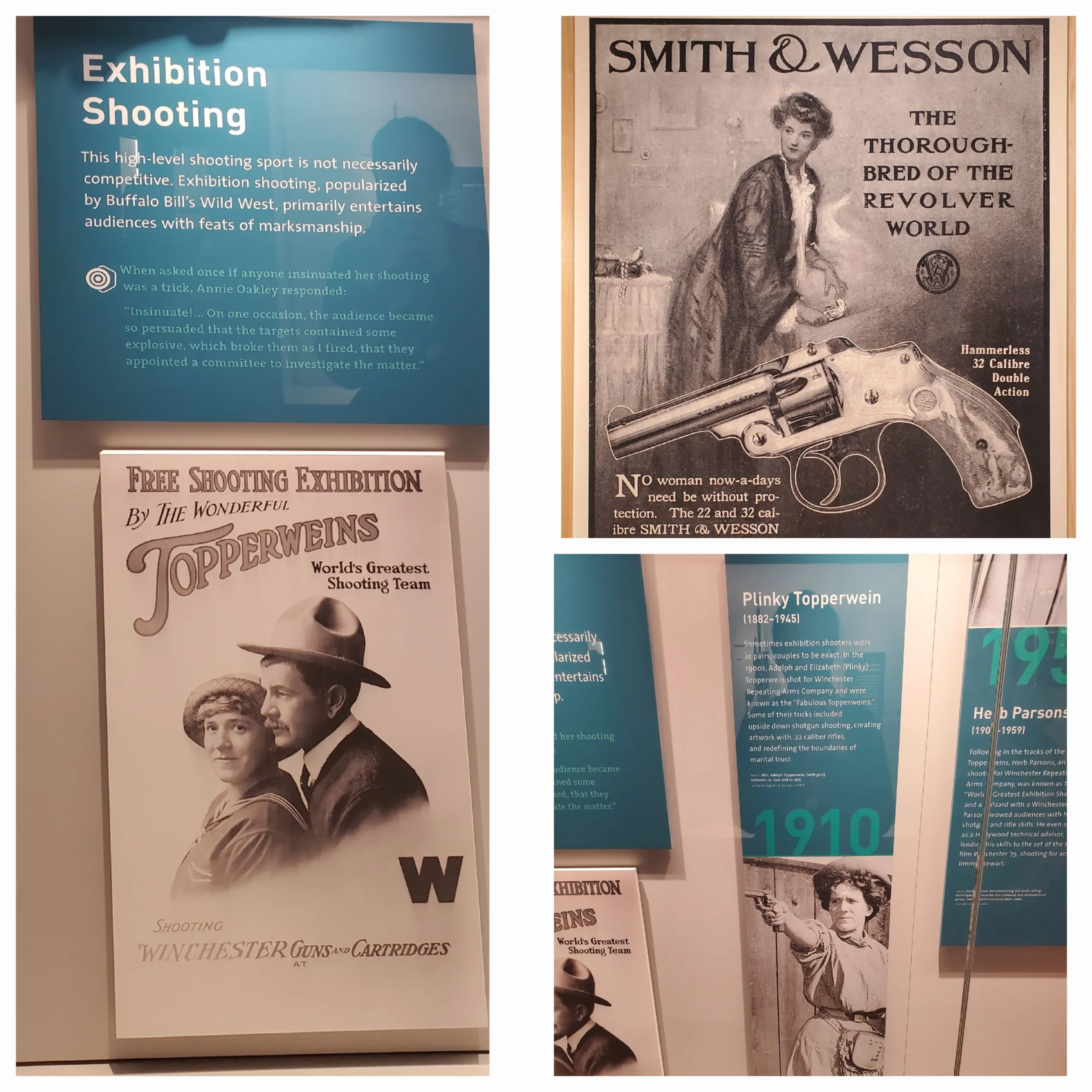
If you ever find yourself in Cody, Wyoming, you simply have to stop at one of the largest and most fascinating museums I have ever stepped foot in, The Buffalo Bill Center of the West.
For one thing, its more than just a regular old museum. In fact, its five museums in one, all located under a single roof!
According to their website, the five museums are as follows: "Draper Natural History Museum, Buffalo Bill Museum, Plains Indian Museum, Whitney Western Art Museum, and Cody Firearms Museum."
I didn't have a chance to step into the art museum, but my mom and I did go through the other four. My favorites were the Plains Indians Museum and the Cody Firearms Museum, both of which I included photos of above.
One of the most fascinating artifacts in the entire building was the actual Native American teepee which has survived to present day. Its hard to get the full experience from a photograph, but picture this. I am five feet six inches tall, and it towered above me!
The Buffalo Bill Center of the West gets its roots from the Buffalo Bill Museum, founded in 1927 by William Cody's niece, Mary Jester Allen. The current location of the center was donated in 1935 by Whitney Vanderbilt. The art museum was added in 1959, and ten years later the Plains Indians museum was added as well. The firearms museum was opened to the public in 1991, with the fifth and final section, the Draper Natural History Museum, added in 2002.
To read a full timeline history of the museum, click here.
To view the museum's website to plan a visit of your own, click here!
If the center sounds vaguely familiar to you, maybe its because one of my favorite history Youtubers uploaded two videos on the center only a few months ago. Below are links to both of The History Underground's videos on the center, which give you a much better look inside at the exhibits.
2021--Fort Caspar and Lou Taubert's Ranch Outfitters, Casper, Wyoming, United States of America
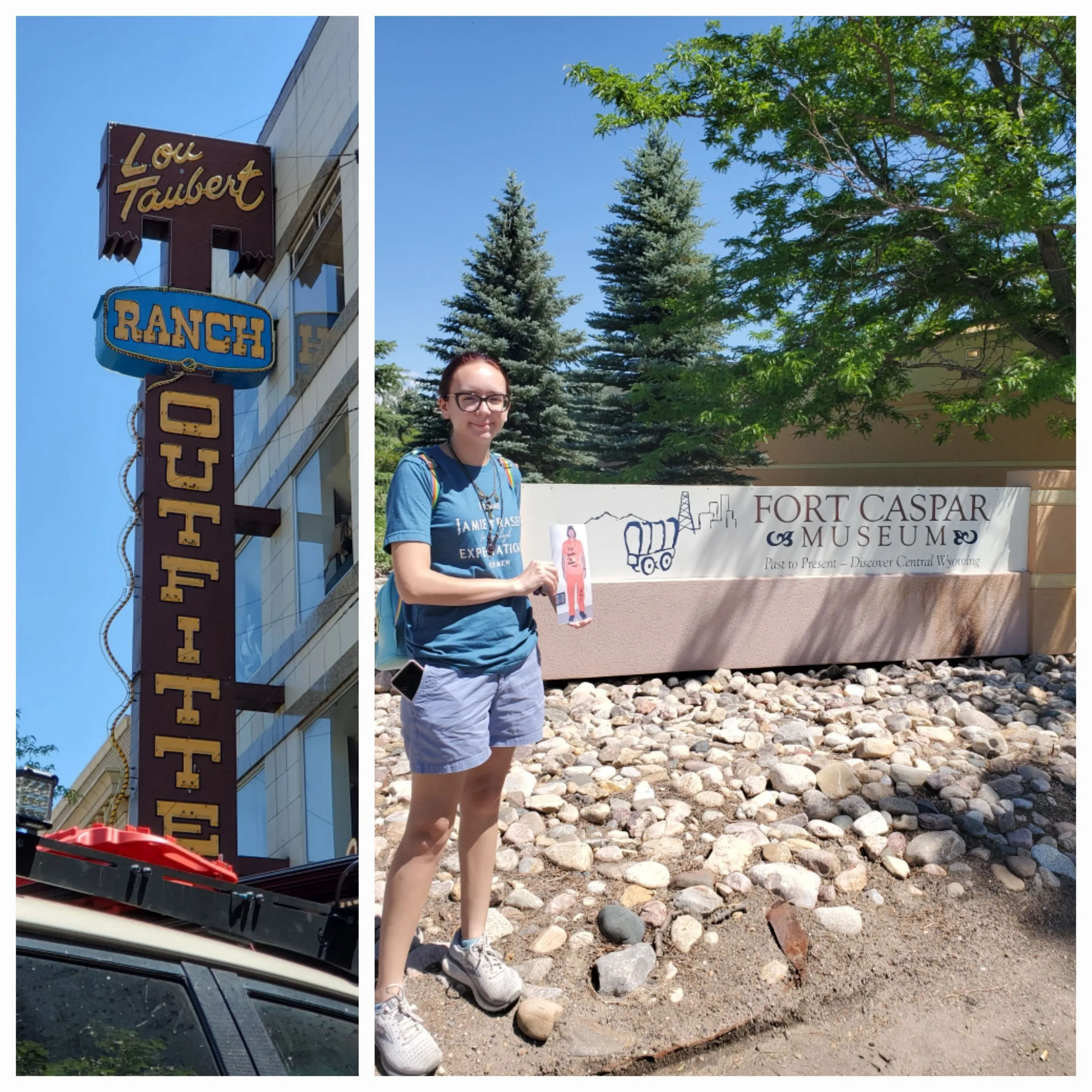
For some of my younger and more internet-attuned audience members, you might read "Casper, Wyoming" and think--JEFFREE STAR!
But unfortunately, while I was in Casper I did not see Jeffree Star or any of his now-famous yaks. This was also before Jeffree opened his "Makeup and Meat" store in Casper as well, but I really want to go back and visit it someday!
(If you have no idea what I'm talking about, the internet personality, makeup mogul, and ranch owner Jeffree Star happens to own a ranch outside of Casper, Wyoming, and he opened a storefront there to sell both his makeup and products from his ranch).
Anyways! Like I said, Jeffree had yet to open his store while I was in Casper, so instead we stopped at the Fort Caspar Museum and the world-famous western wear store Lou Taubert.
Fort Caspar dates to 1847, when Brigham Young led his wagon train of LDS Pioneers across the midwestern states. In June of that year, the pioneers constructed a ferry boat to cross the North Platte river. The remains of that same ferry exist today in the museum, along with other structures built in 1859 that still exist today as well.
If you visit in the summer months, you can walk around those older structures outside and look within. There is also a small indoor museum to walk around as well, and the staff is very enthusiastic about answering your questions.
(They also had a very wide ranging selection of books to buy in the gift shop!)
To learn more about Fort Caspar, visit their website here.
Lou Taubert's, on the other hand, is both a store and a piece of history.
According to their website, Lou Taubert's has been supplying the west with their products since 1919! (Technically the western wear store opened in 1947, but the original owner opened his first store in 1919). I had no idea what to expect when we arrived, but my mom knew she wanted to visit.
In fact, she'd been wanting to visit since she was a member of FFA (Future Farmer's of America) in high school. Visiting Lou Taubert's was checking an item off a bucket list she hadn't actually ever written down, and boy was it worth the stop!
The ranch outfitting store is unlike any other. For one thing, the store is in a building that covers NINE different floors, or approximately 55,000 square feet of floor space. Lou Taubert's is also family owned and has been operating over three generations.
(Which is kind of impressive that they've managed to stretch three generations across one hundred years. My own family has been running our own small local business for just over sixty years and we're on our fourth generation already!)
From 1980 to 2018, the family expanded to having a second store in Billings, Montana, but today they only operate the original store out of Casper.
My favorite part about visiting Lou Taubert's was the extraordinary number of old photographs located around the store. We spent most of our time on the floor with the cowboy hats and other women's clothing. While my mom shopped, I looked around the photos of all the different rodeo queens who had competed across the country for various titles, all of whom seemed to have shopped at Lou Taubert's.
To learn more about this famous store, visit their website here.
2021--The Big Boots of Cheyenne and Lakeview Cemetery, Cheyenne, Wyoming, United States of America
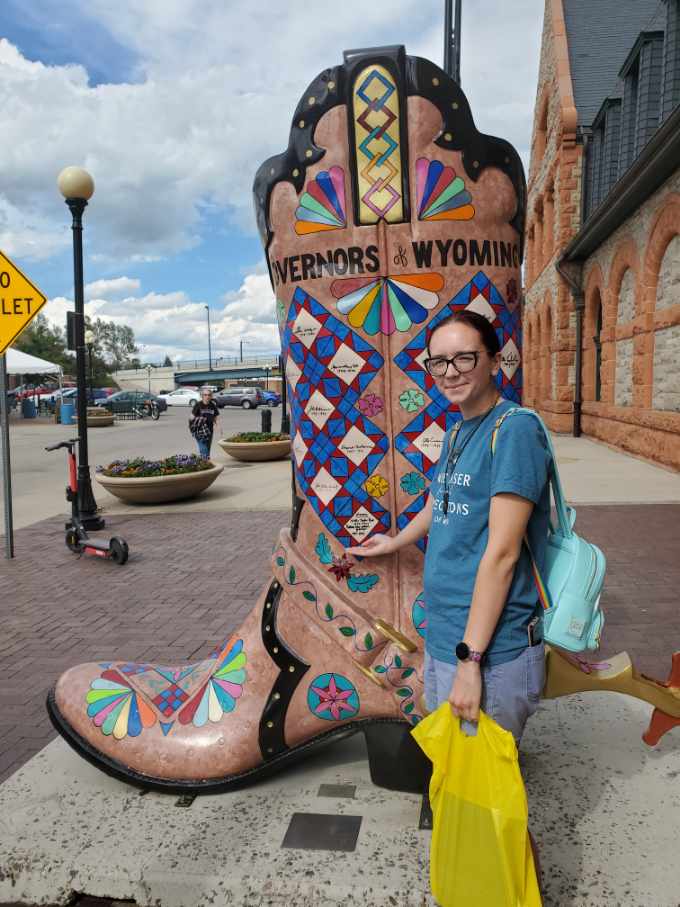
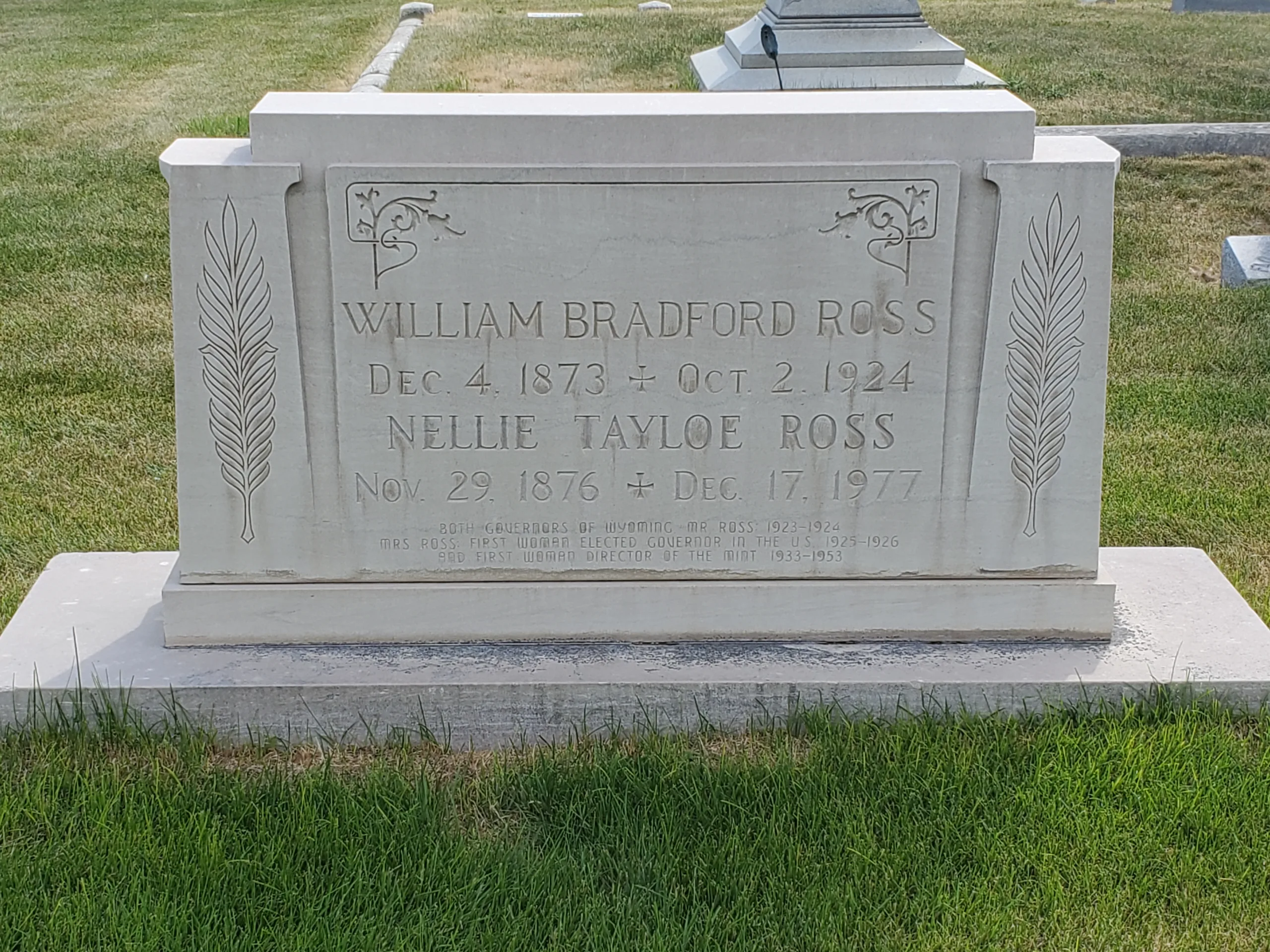
Cheyenne, the capitol of Wyoming. Our last stop in my favorite state in the United States allowed me to visit one of the strangest man-made landmarks in the country, the so-called "Big Boots."
According to an online brochure, which you can read here, there are thirty eight-foot-fall hand painted boots located all over the city. Each was painted by a local artist and shows an aspect of history for Cheyenne or Wyoming. Here I am pictured with the Governor's Boot, which lists--you guessed it--every governor of the state of Wyoming, at least at the time of the boot's creation. I am underlining Nellie Tayloe Ross's name--the first female governor of Wyoming, whom we also stopped to visit at Lakeview cemetery that same day (also pictured).
2021--Visiting the Tabor Ladies, and the Inventor of Tampax, Denver, Colorado, United States of America
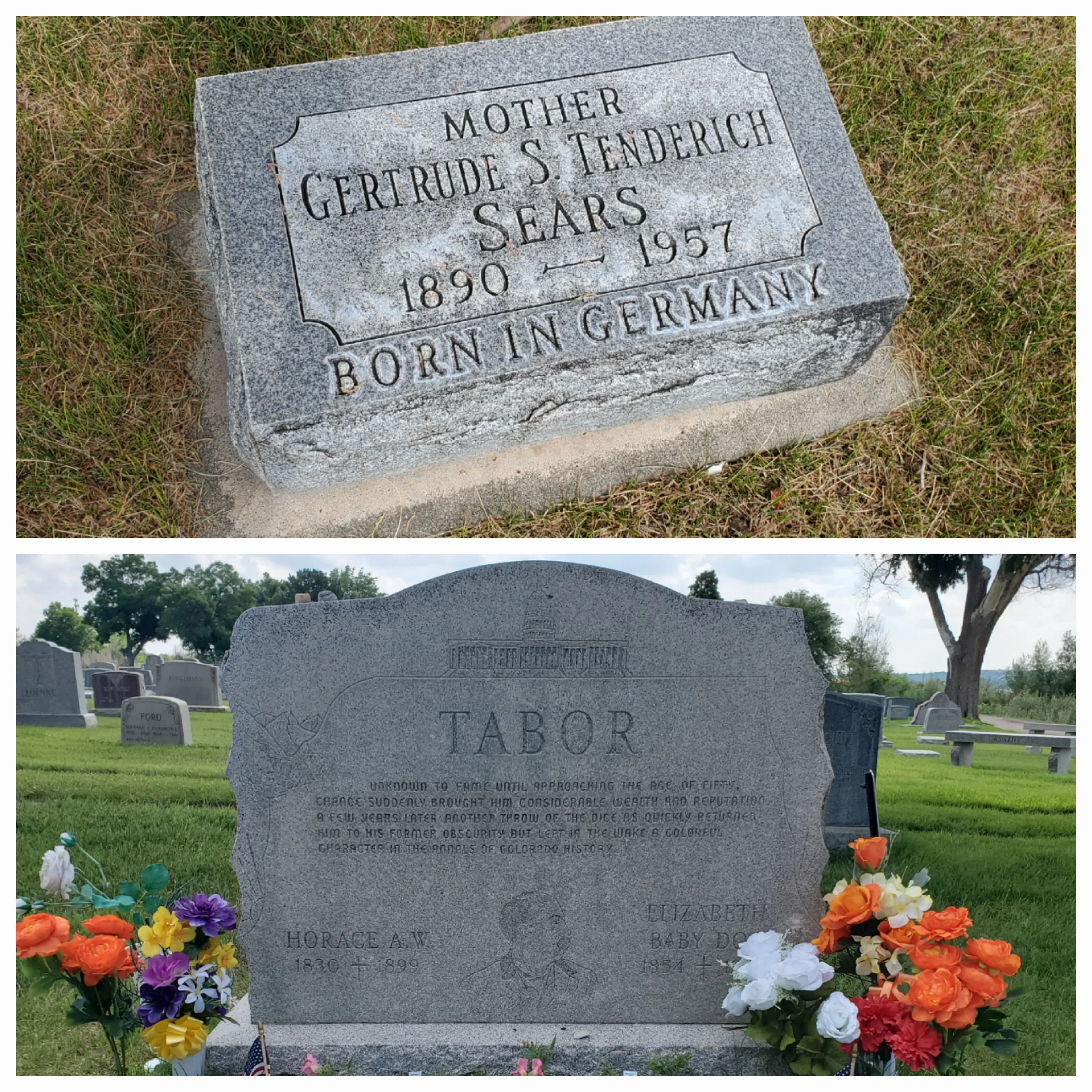
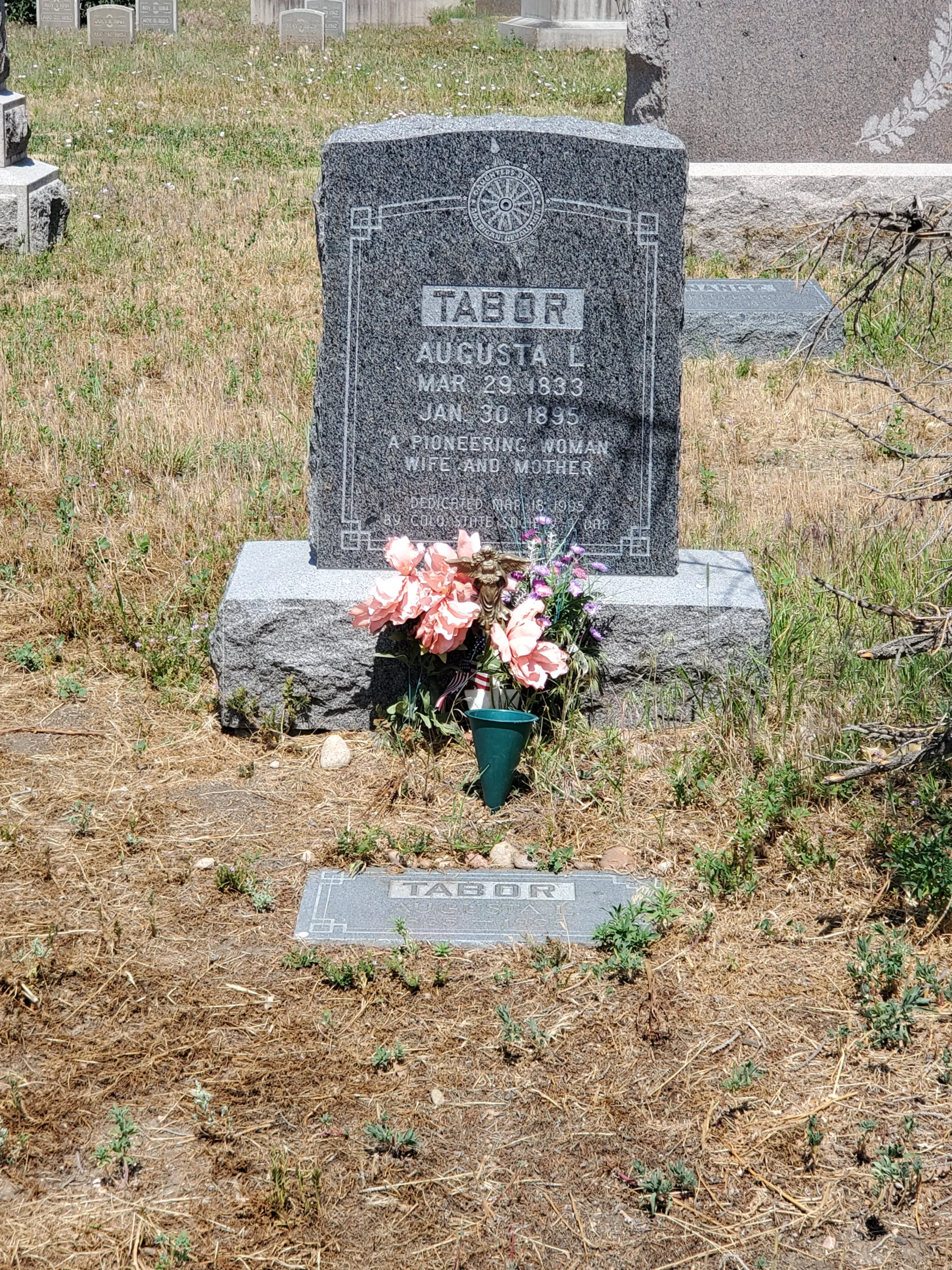
While my mom and I didn't spend a ton of time in Denver on our road trip through, I did make sure to have us stop off at two cemeteries: Mount Olivet Catholic Cemetery (technically in Wheat Ridge, Colorado) and Riverside Cemetery.
At Mount Olivet, we visited both Gertrude Tenderich-Sears, the inventor of the first modern tampon, and Elizabeth "Baby Doe" Tabor, the second wife of silver baron Horace Tabor. Mount Olivet is a beautiful cemetery, with perfectly manicured lawns and interesting headstones in a picturesque environment for those who like to wander.
Riverside Cemetery, on the other hand, was extremely depressing to witness. First of all, it is located directly across the street from a water treatment sewage plant, which made the entire cemetery smell like...well...rotting corpses. If that isn't bad enough, the cemetery is very old and very overgrown. I managed to find Augusta Tabor's grave (the first wife of the aforementioned Horace Tabor) simply because it is tall and easy to spot from a distance, but other graves that were smaller and closer to the ground were almost impossible to identify. My mom and I still took some time to wander, but the cemetery does not have clear roads to drive down or any other markers to help visitors find who they are looking for either, so we didn't stay as long as I would have wanted to otherwise.
2021--The National Museum of World War II Aviation, Colorado Springs, Colorado, United States of America
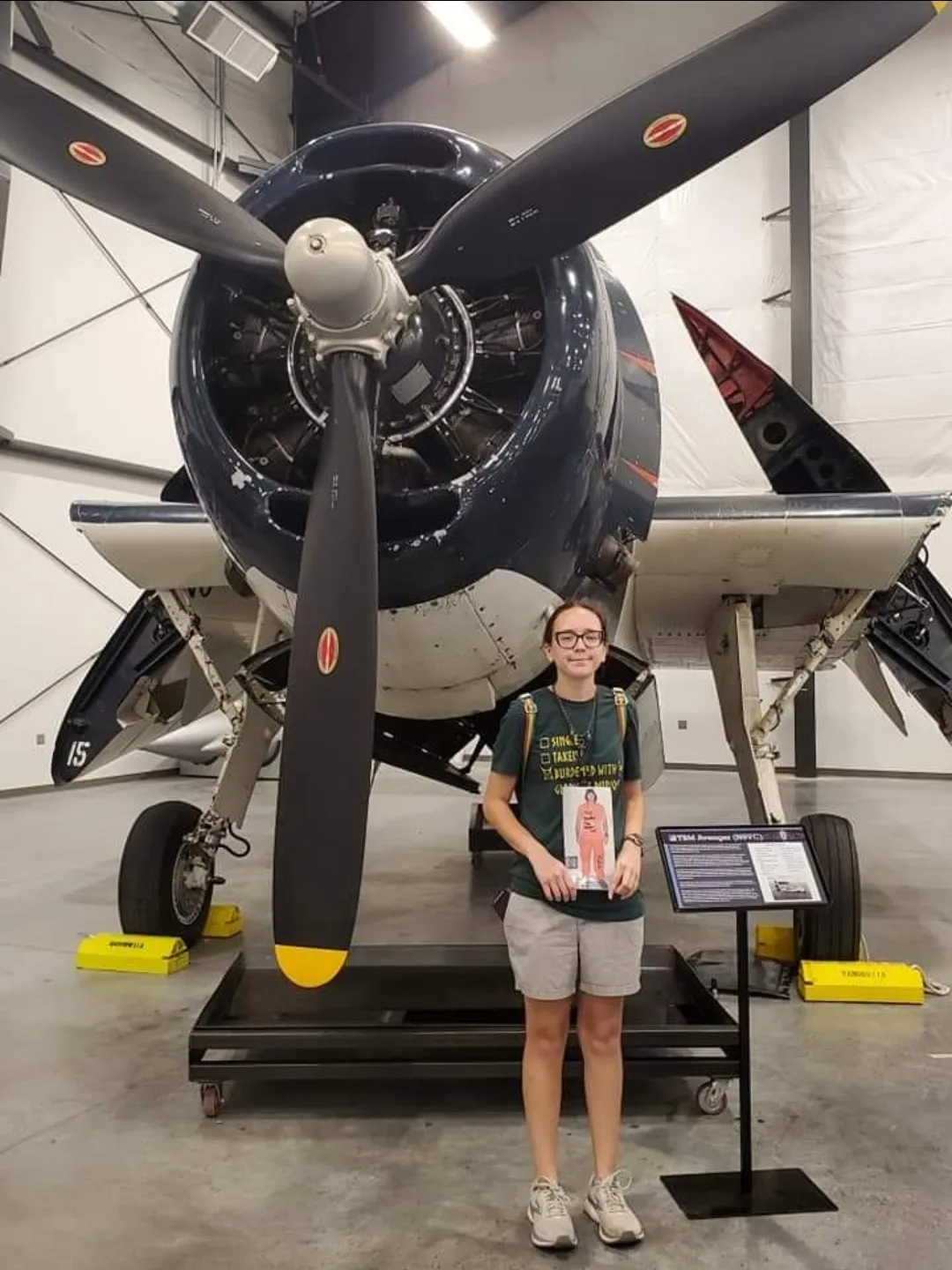
My mother and I found this museum by complete accident, but what a find it was!
I have always loved aerospace museums, and this one was one of the best I've visited so far. Not only is the hangar full of all sorts of old planes, engines, and other machinery from World War II, but the museum also had short biographies on some of the most famous pilots from the period, and before.
The only downside to this museum was the gift shop, which was pretty lackluster, at least when we visited. We spent several hours wandering around, taking in the sights as well as calling and texting various family members, to tell them to stop by the next time they visited that part of Colorado.
To learn more about the National Museum of World War II Aviation, visit their website, here.
2021--The Loretto Chapel, Santa Fe, New Mexico, United States of America
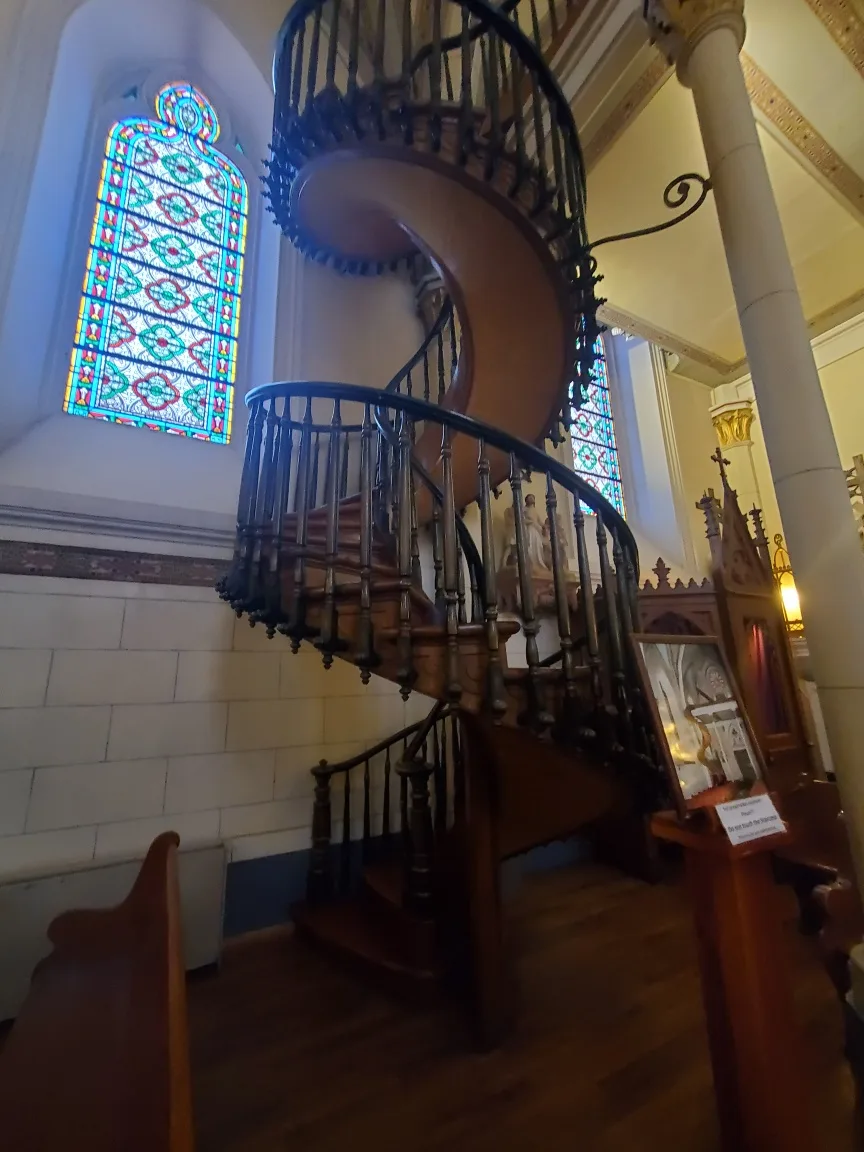
The story of one of the most famous staircases in the world starts in 1850, when the local Catholic order in New Mexico decided a school for girls was needed.
The sisters of Loretto took up the call, and built the Loretto Academy in 1853, after a journey which cost the Mother Superior her life, and during which time the sisters had to quickly learn Spanish in order to communicate with the locals.
Twenty years later, the sisters were able to begin construction of a chapel to go alongside the school. While the architect in charge was able to complete most of the building, he died before he could build a staircase that would reach the chapel's loft.
Because of the shape of the chapel itself, a standard staircase would have taken up too much floorspace and would have shrunk the available seating on the floor of the chapel to make not sustainable. Not knowing what else to do, the sisters of Loretto prayed for nine days to St. Joseph, the Patron Saint of Carpenters.
This is what happened next, according to the Loretto Chapel's Website:
"A carpenter appeared with only a hammer and carpenter’s square. He built what is now known as the Miraculous Staircase with simple tools and wooden pegs. The rare wood is not native to the American Southwest. When the Staircase was complete, it is said that the carpenter disappeared without receiving thanks or payment. The Sisters tried all local lumber stores but could not find accounts open for supplies for their stairs. Some believe the carpenter was St. Joseph himself while others believe that is was someone sent by St. Joseph. What is known is that the Sisters of Loretto prayed, and their prayers were answered."
The stairs are not just beautiful, but practical as well. Designed with two 360 degree complete turns, the stairs provided a way to the chapel's loft while also taking up as minimal floor space as possible. Because of the way they are designed, the entire weight of the staircase lays on the bottom step. They did not originally have railings, but about ten years after the miracle took place, the railings were added to help those climbing up and down.
Today, the Loretto Chapel is as much a tourist attraction as it is a Catholic place of worship. For a couple of dollars per person, visitors can sit in the pews and listen to an audio recording recount the story of the miracle. I very much enjoyed the entire experience, and the gift shop was equally amazing!
To learn more about the Loretto Chapel, visit their website here.
2021--I Debuted as Debutante for Daughters of the American Revolution, Fountain Hills, Arizona, United States of America
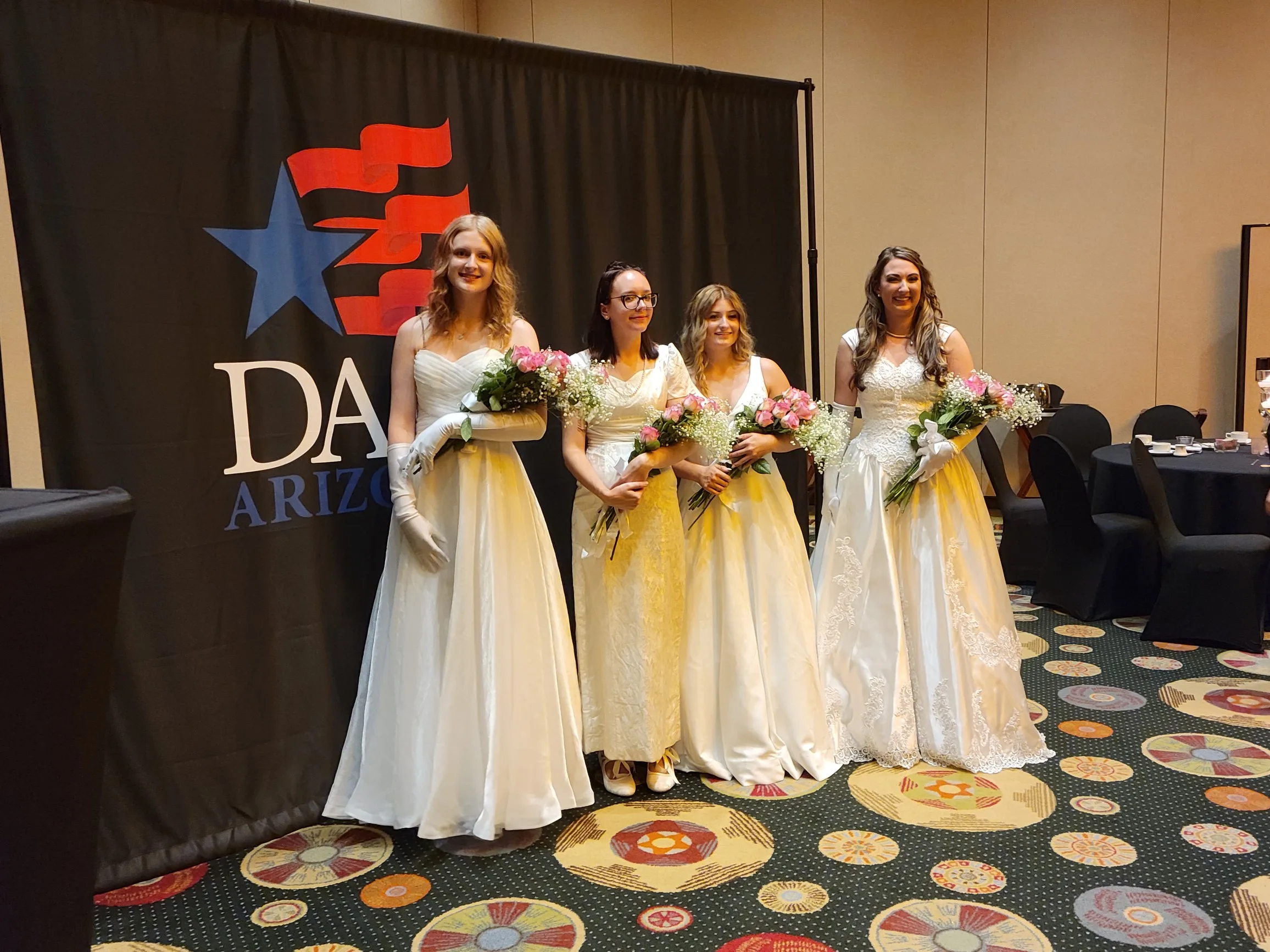
From the time I joined DAR at the age of nineteen, I had it in my mind that I wanted to participate in their version of a Debutante Ball. Girls are allowed to debut as "Debs" between the ages of eighteen and twenty-two in DAR, and so I was originally supposed to be a part of the ball in 2020 (the first year I was eligible because the ball only happens once a year, and had already taken place by the time my paperwork came through in 2019).
Well, then covid happened.
I feel like no further explanation is needed than that!
So, 2020 was out for that particular endeavor, but luckily the ball was rescheduled for 2021 and I was ready to go.
I'm not wearing them in this particular photo, but I did have white gloves that I wore for part of the ceremony. There were five of us debutantes in all that year, but one of the girls missed this photo. I wore a long ivory gown with a bow on the back, and my grandmother Helen's pearls. My stepsister did my hair, I managed to do my own makeup, and my father served as my chaperone for the presentation itself.
Part of the reason why I agreed to take part in the ball was because I knew it would be the only time my family would see me in a white/ivory formal gown. Ever since I was a child I have been determined to marry in a black gown (the color of life in Ancient Egyptian culture) and not white. White wedding dresses only became the fashion after Queen Victoria married Albert in a white gown (before their fairy tale wedding, women usually married in the nicest gown they already owned, regardless of color). Not only that, but white is also the color associated with death in Ancient Egyptian culture--and neither of those traditions particularly excite me when I think about my future wedding.
With that tangent aside, however, I definitely think being a debutante counts as a historical venture I took part in. As for what a debutante ball actually is... well, that largely depends on who you ask and whether or not you identify as a feminist.
Historically, debutante balls were a way for young women in high society to debut themselves. What this meant was, when a girl reached the age in which she was eligible for marriage, she would "come out" to society to introduce herself, her family, and what all she could bring to her marriage.
Today, many feminists view debutante balls as something to look down upon, because they view these ceremonies as though women are being presented for the sole purpose of getting married and being a man's property. Whether or not you agree with that is up to you and has nothing to do with this blog post, however.
While the first confirmed date for a debutante ball has been lost to history, the first notable ball that has made it into the history books dates all the way back to 1780 in England. The last presentation of ladies in England in this manner ended in 1958.
I enjoyed my night as a debutante--except for the fact that my dress was fairly tight and I had to keep standing up and sitting down, over and over, for standing ovations and various other reasons. Other than that though, the night was quite fabulous!
Because the ball I debuted at was a part of DAR, I was sponsored by my chapter, Cactus Wren. The three other girls in the photo with me were all from the same chapter, and the fifth girl was from a third beside that. The DAR Debutante Ball is a good way for younger DAR members to get to know one another, and show our community that DAR is not just for little old ladies. While some of the other girls wore their mother's wedding dresses, or a dress they bought online, I chose to buy my dress from a local store that only sells modest dresses, "Modest Wedding and Prom." I was happy to support a local business and loved my dress! I bought it even though they offered rentals, even though I doubted even then that I would ever wear it again.
To learn more about the history of Debutante Balls, here is an article from Encyclopedia Britannica.
2022--Visiting Pearl Hart's Grave, Central Heights, Arizona, United States of America
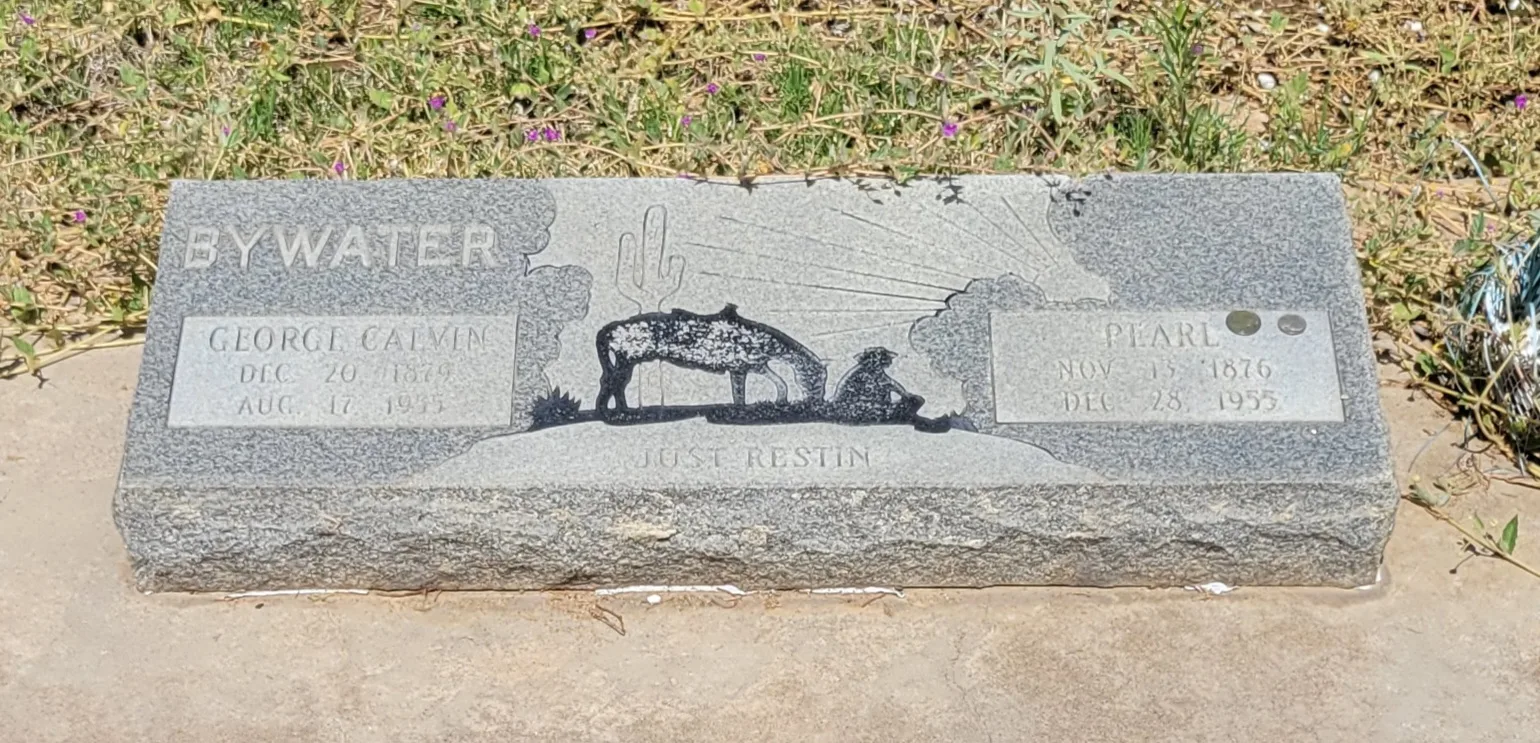
As you can tell, I like visiting historic cemeteries and well, dead people. I can't believe it took me nineteen years of living in Arizona to realize Pearl Hart is buried in my home state, but in July of 2022 I got the chance to visit her in person.
To learn more about the cemetery Pearl is buried in, read my blog post about it here.
2023--Hearing Zahi Hawass Speak at a Lecture, Phoenix, Arizona, United States of America
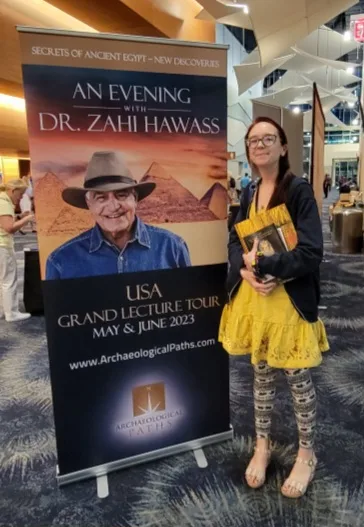
I won't say much about it here because again, I already wrote a blog post (that you can read here), but ever since I was a little girl, Zahi Hawass has been my hero, and so when I found out he was coming to Phoenix I had a proper fan-girl freakout.
Yes he is an old man who is an archaeologist, and I was a twenty-three-year-old-girl at the time, but still! Dr. Zahi Hawass! Chances are if you have watched a documentary on Ancient Egypt at any point in the last twenty years he was probably in it. Thanks again to my mom for getting us the tickets! This was a dream come true.
2023--My First Rodeo, Taylor, Arizona, United States of America
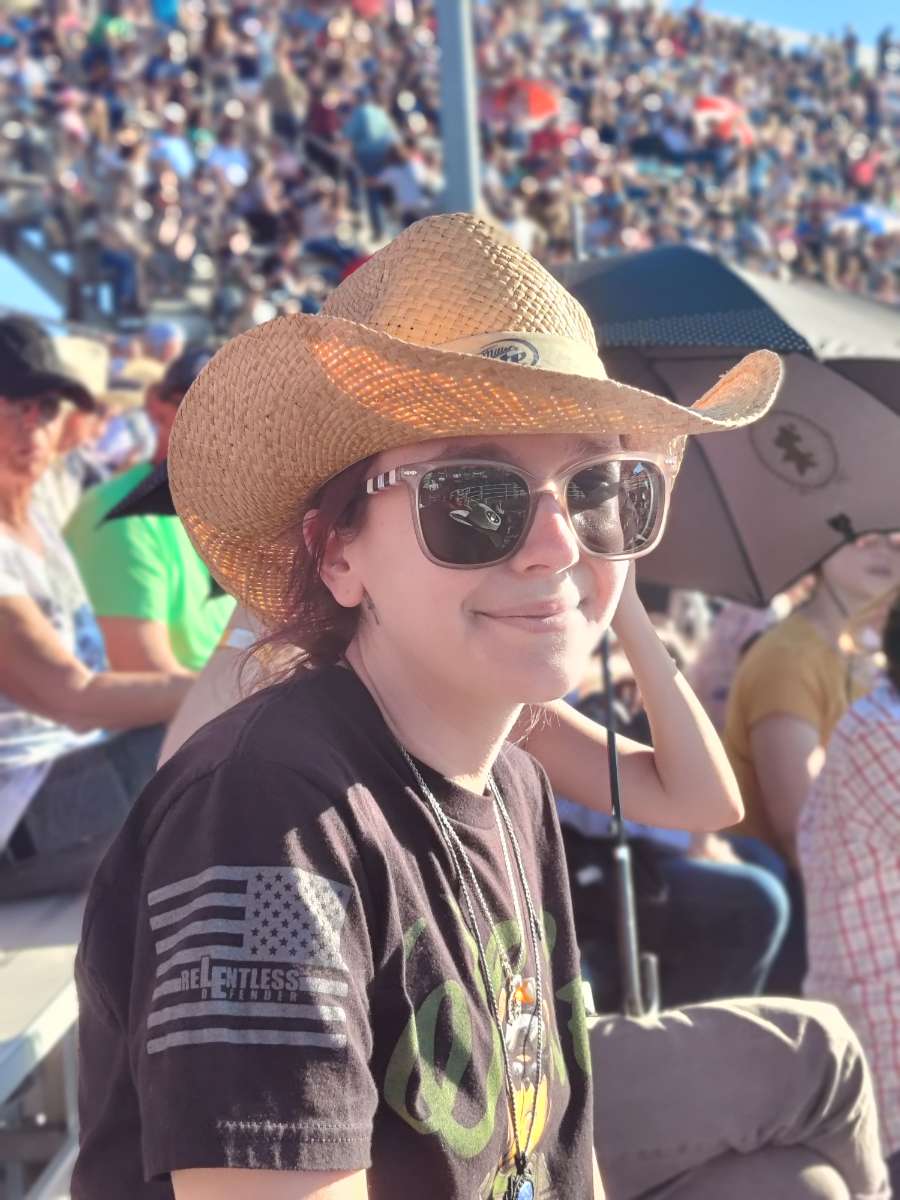
How I managed to make it to twenty-three years old without seeing a real rodeo, I'm not sure, but wow was Taylor a great place to start!
Before I met my boyfriend in March of 2022, I had heard of the town of Taylor, had driven through a time or two, but it never registered as anything more than that, a town up north.
After meeting my boyfriend, that all changed. Taylor is a little slice of heaven to his family, and a big part of the reason why is the fact that his ancestors literally helped found the town. According to the town of Taylor's website, the founder of Taylor, AZ was James Pearce, my boyfriend's great-great-great-grandfather through his paternal grandmother's side.
My boyfriend's family still owns a house in Taylor, which has been in the family for generations, and every year they go up for the annual rodeo. 2023 was Taylor's 69th Annual Rodeo, and it was AWESOME. I can't wait to go back again.
The only downside? The rodeo takes place over 4th of July weekend and it was a bit toasty to say the least. The weather was in the low nineties and it was bright and sunny. My cowboy hat and sunglasses were a lifesaver until the sun went down. If you ever want to visit the rodeo, plan on arriving early! Almost as soon as the gates open, the bleacher seats will be packed full, even though the main event doesn't start until hours later.
The rodeo featured all of the typical rodeo competitions you might expect: bronc riding, bull riding, barrel racing, trick riding, calf roping, and more. They also kicked off the night with an anvil launching!
And in the future...
I know I will have more historical adventures in the years to come, but I thought a fun way to kick off 2024 would be to look back on my life and everything I've done so far.
In the future I will continue to update my website with blog posts every time I do anything fun and historical in any way, but again, I thought this would be a good way to start the year and to remember all the places I've been and the things I have seen. I have a passport, but I've never left the United States. I'm about to turn twenty-four, and I think I've seen and done quite a bit in my time already.
To the future!
And beyond 🙂

